The three initiators of the REHEMA Hospital in Goma, Congo: Reverend Jacques Balibanga, Pastor Chris Zimmermann, Surgeon Gottfried Lemperle
project
Centre Hospitalier REHEMA (in Swahili: mercy)
Financier: Interplast-Germany e.V.
Secretariat: Camilla Völpel
Hauptstraße 57
55595 Roxheim
Germany
Telefone: +49 (0)671 480-280
Prof. Dr. Gottfried Lemperle
Wolfsgangstr. 64
60322 Frankfurt am Main
Germany
Telefone: +49 (0)69 1302-4217 lemperle8@aol.com
Donations in €:
to Goma Hospital Kongo
Titulaire du compte: INTERPLAST-Germany e.V.
Sparkasse Rhein-Nahe Bad Kreuznach
IBAN DE44 5605 0180 0017 1686 18
BIC MALADE51KRE
Why a fourth INTERPLAST hospital in Congo?
Einführung: Since 1980, INTERPLAST-Germany. eV has been sending surgical teams to developing countries to effectively operate on patients with plastic surgery problems (congenital malformations, burn contractures, tumors, accident sequelae, etc.). From 2015 to 2018, I was also active with a small team in the operating room of the CEDIGO blood bank, where we operated on over 500 patients, mainly with large facial tumors and keloids, with the help of local surgeons in four missions.
The Goma Hospital is designed to reach people in the immediate vicinity who live in the poorest of conditions in the slums of Goma. The current team of four volunteer doctors and seven helpers treat approximately 300 to 500 patients per month. Many receive medication or vaccinations, and some with minor wounds are treated. All difficult cases currently have to be referred to one of the five major hospitals – by ambulance on a motorcycle.
The Goma Hospital is intended to reach the 90% of the population who are poor and their families, who cannot afford treatment by a doctor or at one of the five larger hospitals. The initial aim is to provide basic care, which should also include vaccinations and awareness campaigns for girls and pregnant women.
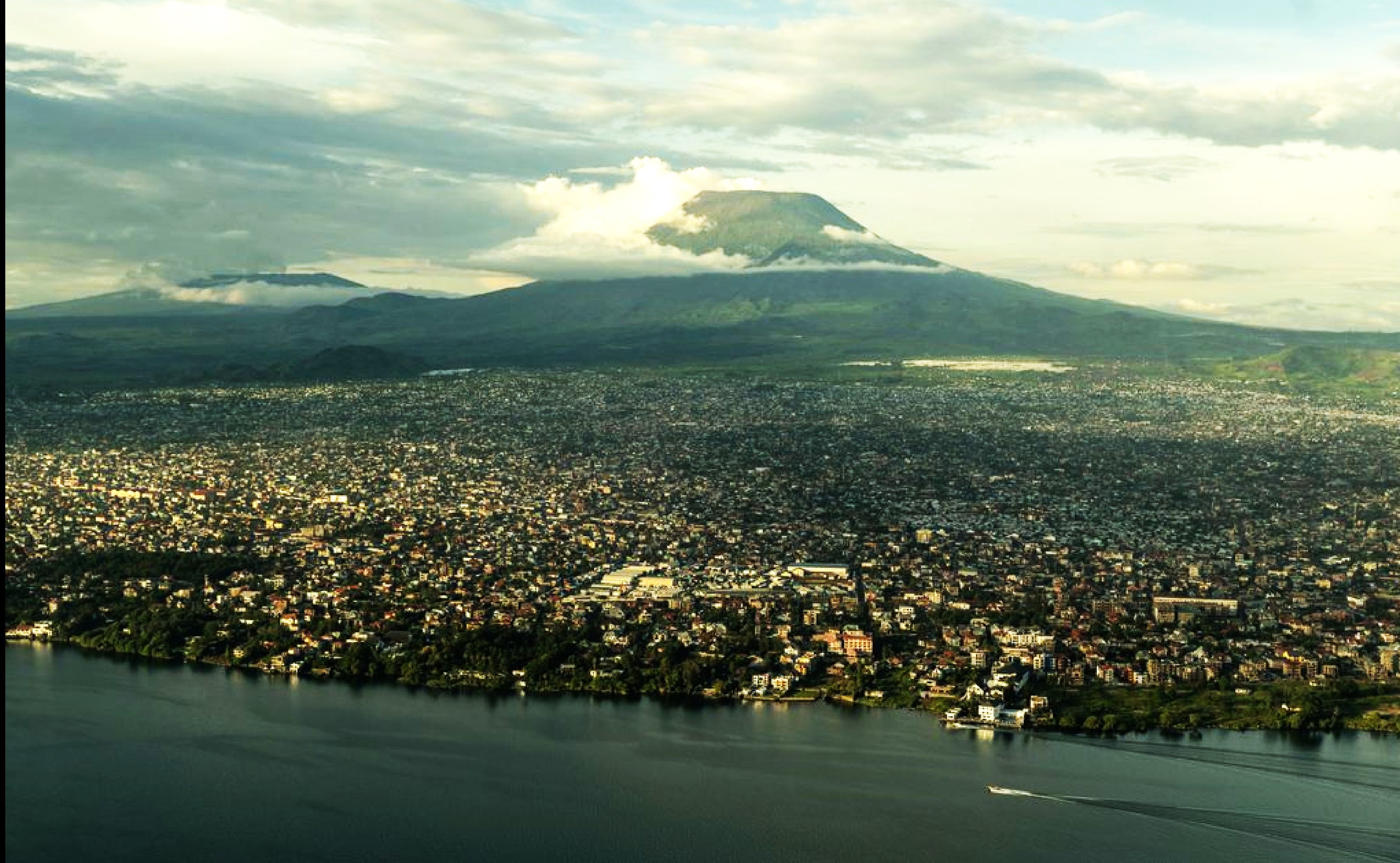
We were invited by Pastor Cris Zimmermann of the Kirche-in-Aktion (KiA) in Frankfurt/Main and Reverend Balibanga of their partner organization People-in-Action International (PAI) in Goma. My son Andreas is an active member of the KiA and was supposed to expand a school in Goma as an architect. At the same time, Reverend Balibanga organized a mission for a small INTERPLAST Germany team.
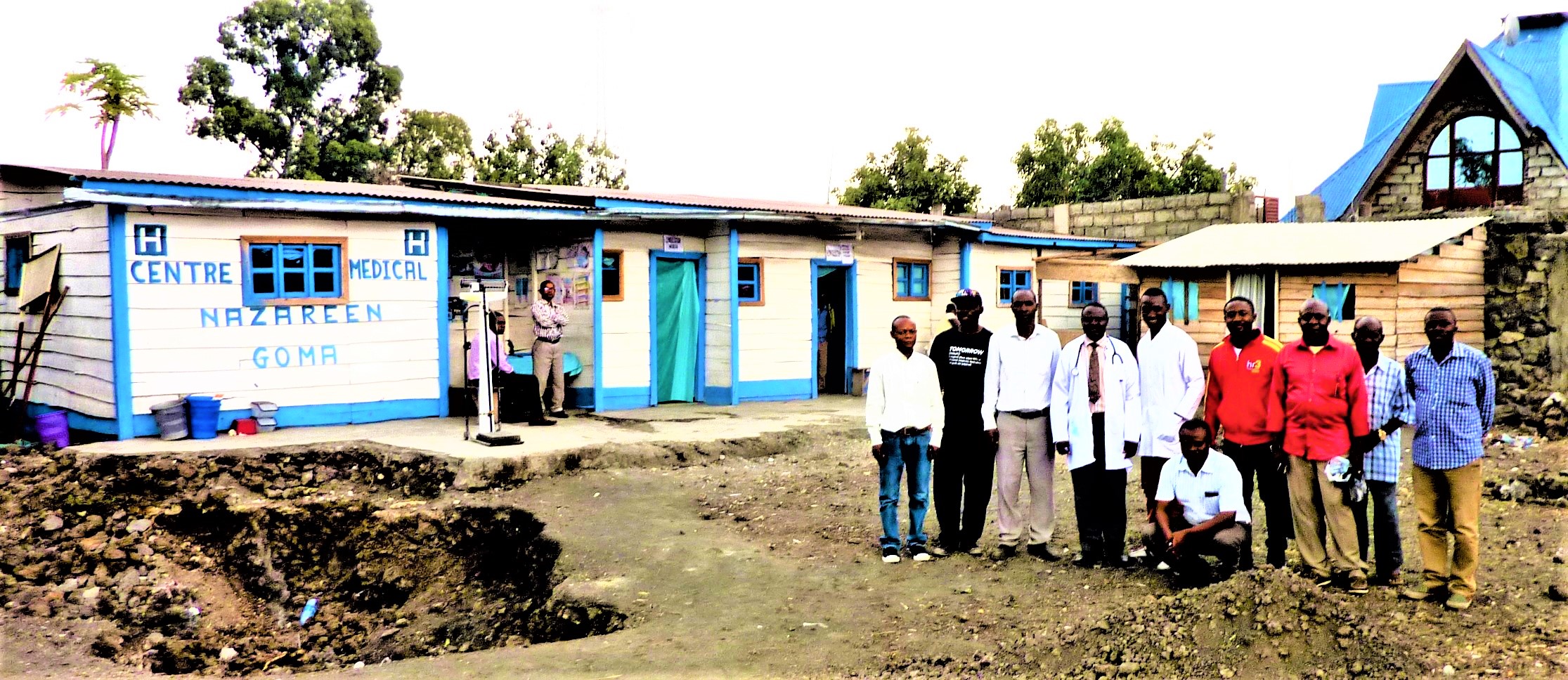
PAST CARE of poor patients
Until now, the simple outpatient clinic with five treatment rooms without light and with few medications was located in the middle of Goma, on the grounds of the Church of the Nazarene. It was run by four doctors and seven other helpers. Apart from prescribing medication in emergencies (painkillers, antibiotics, blood pressure reducers and diabetes therapies), they were unable to do much. There was no laboratory, ultrasound or X-ray equipment. Since 2015, five Interplast teams had operated on over 1,200 patients with the local surgeons in a blood bank. In the process, the need for a small hospital for the needy people in the surrounding area was recognized.
During a visit to their Centre Medical Nazareen, we discovered a woman moaning on the floor of a dark little room. “She has angina.” “Yes, does she have painkillers and antibiotics?”
“No, we don't have any.” ‘Then come with us to CEDIGO, we have a suitcase full of them!’ Two days later I asked how the woman was doing? ‘She died that same night.’ ‘Oh God, with angina these antibiotics work overnight!’ ‘She would have died, so we saved the medication for other patients’...
This tragic event moved me so much that I suggested to the superiors of the Nazarene Church that a modern hospital for the poor be built on their property. The Bishop of the Nazarene Church, Reverend Bugeshi, generously provided the land on which his community celebrated services and he lived.
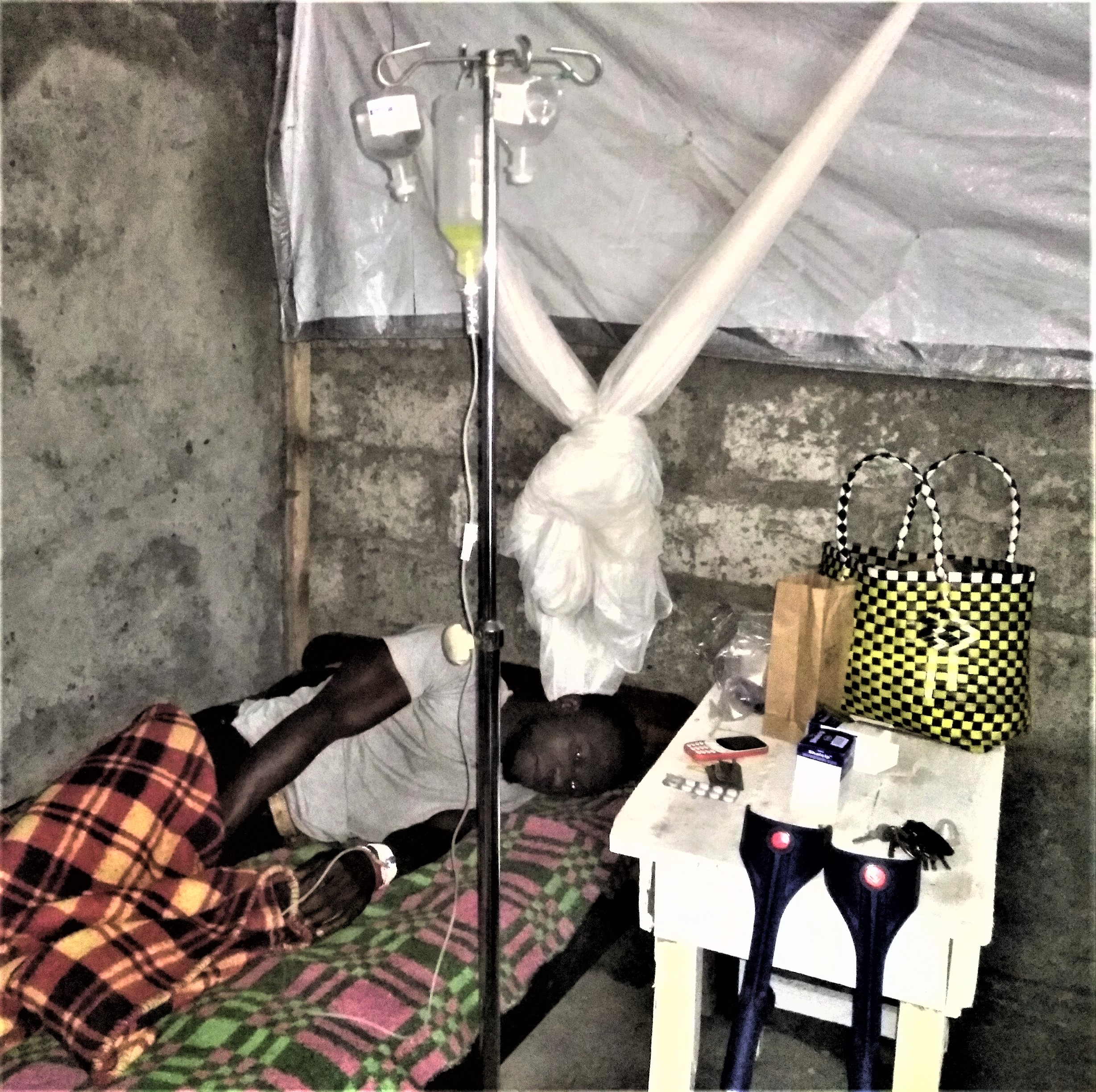
I also recognized the great need of the many polio-paralyzed and leg-amputated people in the surrounding villages, who spend their lives begging in the dirt of the streets or who have to crawl to school.
Goma on Lake Kivu on the border with Rwanda. In the background, the ever-seething volcano Nyiragongo, which last erupted on May 22, 2021.
Goma, a city of 2 million on the eastern border with Rwanda, is the seat of the UN Refugee Agency and its UN blue helmets in Africa. Under Belgian rule, Goma was known as the Las Vegas of Africa because of its climatically pleasant location on Lake Kivu.
On the other hand, Congo has been constantly embroiled in civil wars since its independence from Belgium in 1960, and large parts of the northeast are still ruled by rebels. More than 1 million refugees from the rebel areas are currently eking out an existence with no future in UN tent cities around Goma. In 2003, 2/3 of the city was flooded by a stream of glowing lava from the eruption of the nearby volcano Nyiragongo.
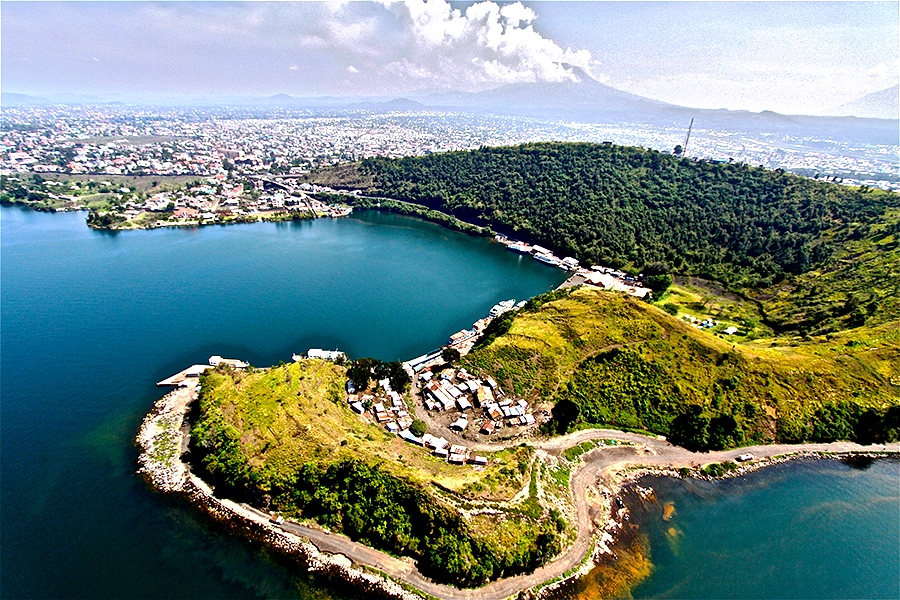
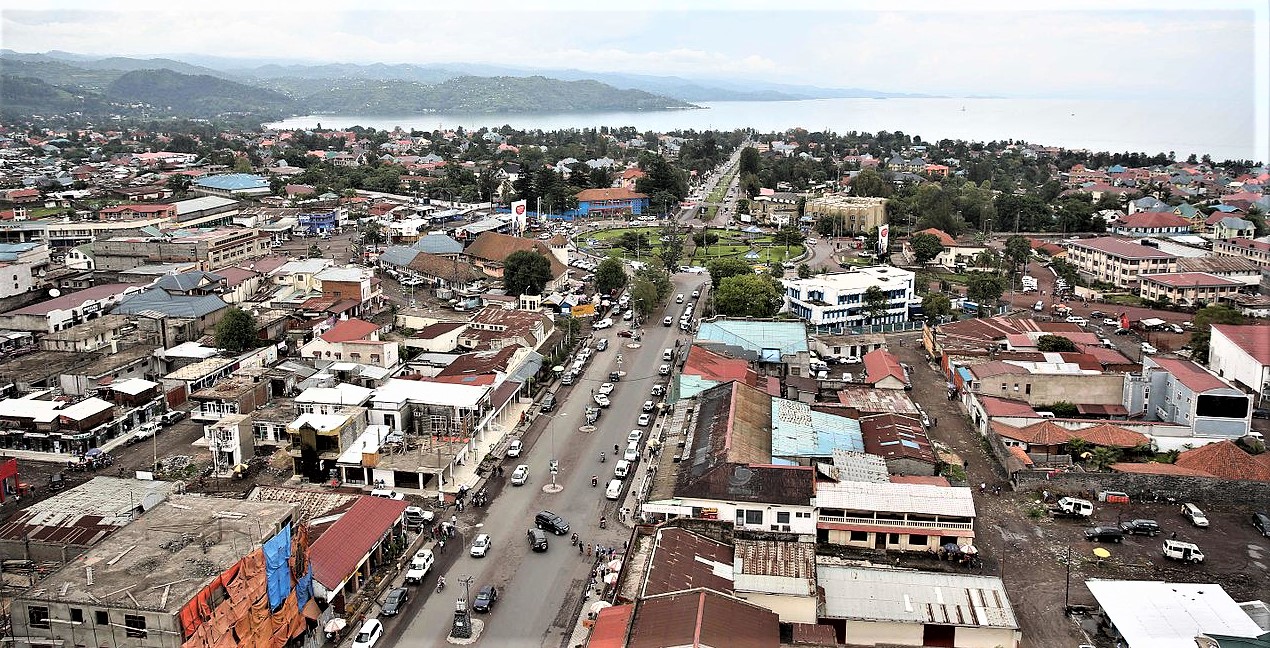
Because of its good climate at Lake Kivu, at an altitude of 1500 meters, Goma was the Las Vegas of Africa under Belgian rule until 1960 and remained so until 1965. In the background, the forests of Rwanda, a rich country that was inundated with aid money after the horrific genocide in 1994!
Due to their wealth of gold, diamonds and rare earth elements, many areas in eastern Congo are still occupied by rebels who raid the villages for food. Crowds of refugees therefore make their way to the big cities, where they end up in the UN tent cities with no prospect of work or income. Unfortunately, there is no end in sight to this disaster, nor a return to their abandoned villages.
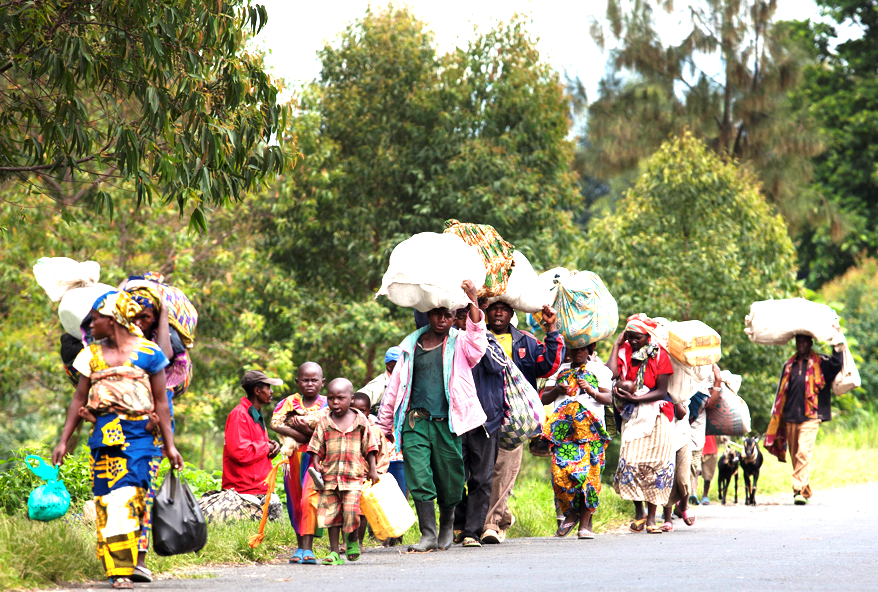
After 24 years of experience with our Nepal Hospital www.nepalhospital.de, the most important requirement for a hospital in foreign countries is the trustworthiness, reliability and selfless commitment of the local doctors - especially in the corruption-stricken Congo. For six years, the four doctors there have been treating poor patients who could not find anywhere else to go, out of their Christian faith, i.e. for God's sake in Congo.
From 2015 to 2019, five INTERPLAST teams worked with surgeons at CEDIGO in Goma to operate on over 1,200 patients (see “Patients Operated on in Goma” below), and in doing so recognized the absolute necessity for the construction of a small hospital on the grounds of the local Church of the Nazarene.
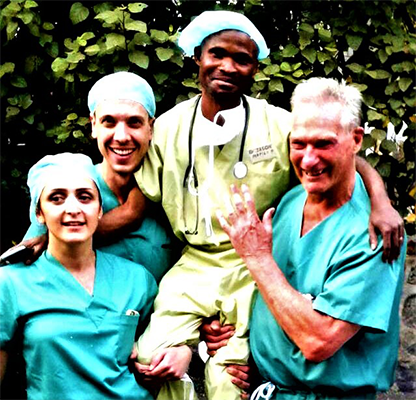
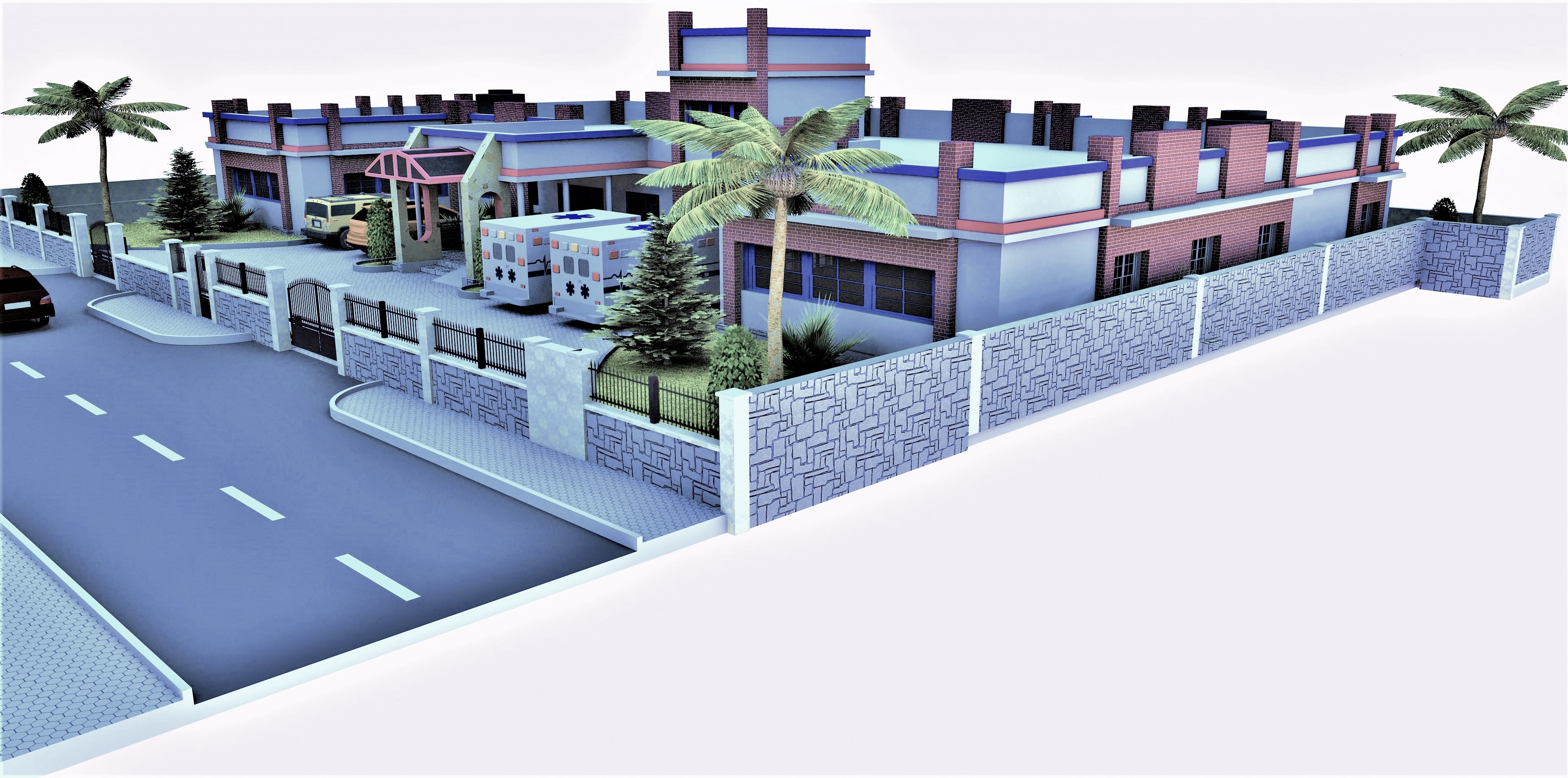
The terrible experience described above was the starting point for a hospital for the poor on the Nazarene's property. Many friends, family, and also the Church-in-Action in Frankfurt participated in the initial search for a monthly support of $2,000, which initially financed a wall around the area. An inheritance from our mother's house (shared with my 7 sisters) then made the groundbreaking possible in November 2020.
My architect son Andreas and I, together with architect Henry Kawaya, had designed a ground-level surgical outpatient clinic that could later be expanded with three additional floors if funding was provided. The planned REHEMA-Centre Hospitalier (REHEMA is Swahili for mercy) received the building permit and the blessing of the Ministry of Health in July 2020.
My various applications via INTERPLAST-Germany, e.V. to the Federal Ministry for Economic Cooperation and Development (BMZ) in Bonn and to the Else-Kröner-Fresenius Foundation (EKFS) in Bad Homburg were unfortunately rejected due to “insufficient sustainability”. However, INTERPLAST generously stepped in so that the exterior construction could be completed in April 2022.
I chose the interior furnishings (beds, office and kitchen) at IKEA in Frankfurt; they reached Goma in a first container via Hamburg and Dar-es-Salaam in November 2022. I ordered the medical anesthesia equipment and surgical operating equipment from YsenMed in GuangZou, China, for a fifth of the price in Europe or Goma.
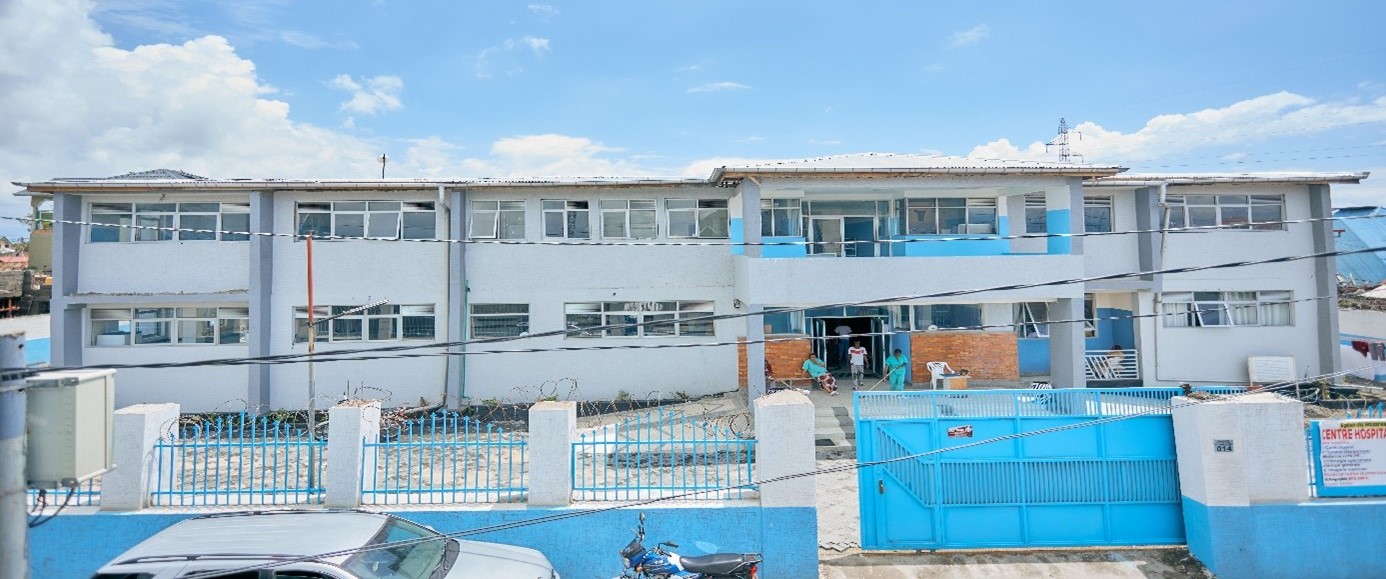
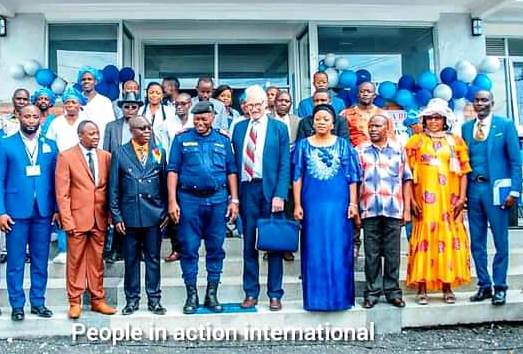
After a successful INTERPLAST mission under Dr. Christoph Sachs from Berlin and Prof. from Lübeck in November 2022, the hospital was officially inaugurated by the military governor Constant Ndima Kongbader and many guests on March 1, 2023. Four doctors, two administrative staff, six nurses, one laboratory assistant and one pharmacist, as well as two cleaning and two security staff took up their duties and have since been treating patients with surgical problems, pregnancies, and internal medicine issues. Difficult cases are referred to or transferred to the “Heal Africa Hospital”, which is five kilometers away.
The former Medical Director, Dr. Ephraim Zibona, is currently training as a gynecologist at the Heal Africa Hospital, as are the future internist Dr. Jean Bakuka and future pediatrician Dr. Olivier.
The new hospital
The initiator and coordinator of the project, Dr. Gottfried Lemperle, and his son Andreas Lemperle (an architect) designed a single-storey surgical outpatient clinic together with other architects and doctors on site. After completion and commissioning, a second floor was added. The planned Center Hospitalier REHEMA (Rehema means mercy in Swahili) received building permission from the building authorities and the Ministry of Health in July 2020. The hospital will initially have a capacity of 16 beds and will include an operating room, sterilization room, 24-hour outpatient clinic with 3-4 doctors, and various monitoring rooms. Meanwhile, in July 2024, the second floor was inaugurated, with departments for gynecology, obstetrics, pediatrics and, above all, neonatology (unique in Goma!).

A. Construction Project
Initiators of the REHEMA Hospital
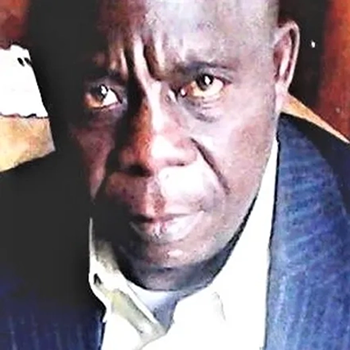
Reverend Bugeshi
Bishop of the Nazarene Church in Goma
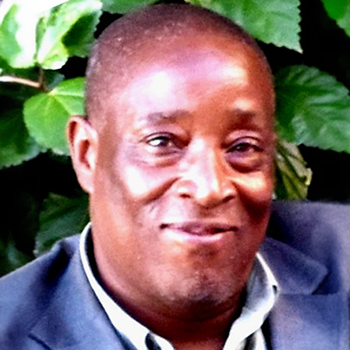
Jaques Balibanga
Missionary of the Nazarene Church
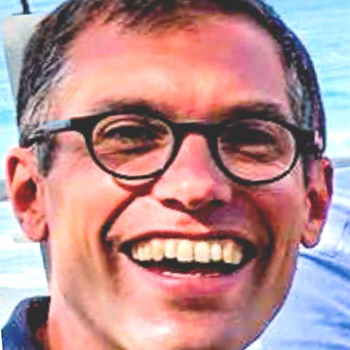
Cris Zimmermann
Pastor of the Church in Action in Frankfurt/Main, Germany
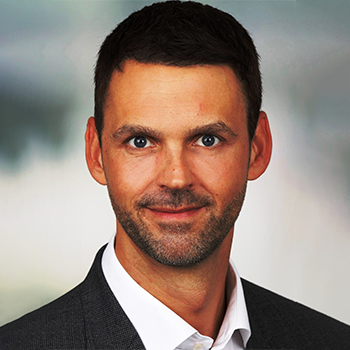
André Grajetzki
Organizer of Church in Action in Frankfurt/Main, Germany
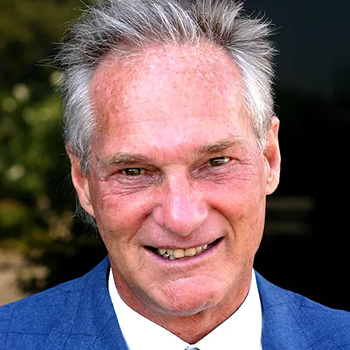
Prof. Gottfried Lemperle
Prof. Lemperle was a plastic surgeon in Frankfurt/Main and San Diego, CA (USA).
He founded Interplast-Germany, 1996 the Nepalhospital and in 2020 the Gomahospital and operated with 6 INTERPLAST teams in Congo between 2015 and 2019.
REHEMA Architects
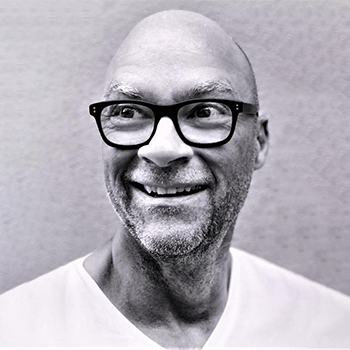
Andreas Lemperle
Architect in Frankfurt/Main, Germany
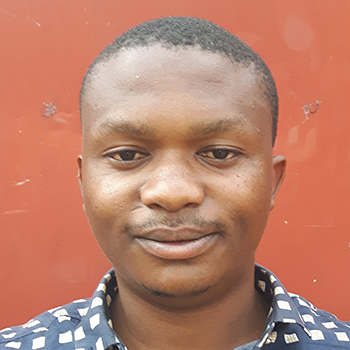
Henry Kawaya
Architect of the ground floor
and design of the 4-storey
later hospital
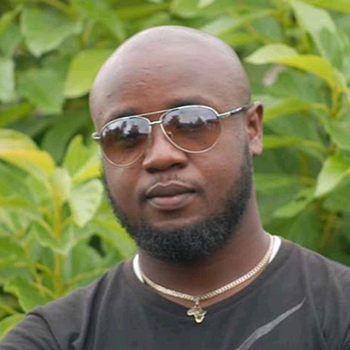
Gedeon Balibanga
Site Manager
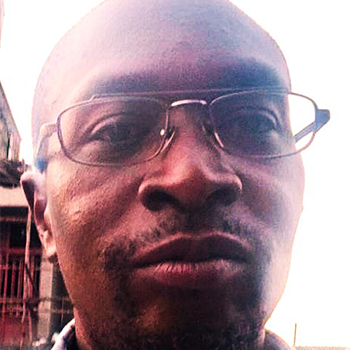
Yves Amani
Architect of the first floor
and outdoor facilities

The foundation stone, which was financed by donations, was laid by Rev. Balibanga on December 2, 2020.
The first interior fittings and equipment have also been secured through donations. The building was ready for occupancy in early 2023. Further funds had to be raised to purchase necessary medical equipment and to provide further training for local doctors.
In these three rooms, treatments took place without diagnostic equipment and appropriate medication.
The hospital is located in the center of Goma, 80m from the main road that separates the slums (top) from the rich (bottom). The nearest major hospital is “Heal Africa” 2.5km away (in the lower right corner).


The building site (bottom center) was provided by the Church of the Nazarene. The wooden church with a tin roof was demolished and replaced by a new stone church financed by INTERPLAST-Germany at a different location.
Thirty construction workers were employed for a day's wage of $5.00 (normally $2.00).
With us, four workers with a cement mixer and a hoist would have finished the roof in a day; there it took three weeks, but provided lodging and bread for 30 families.
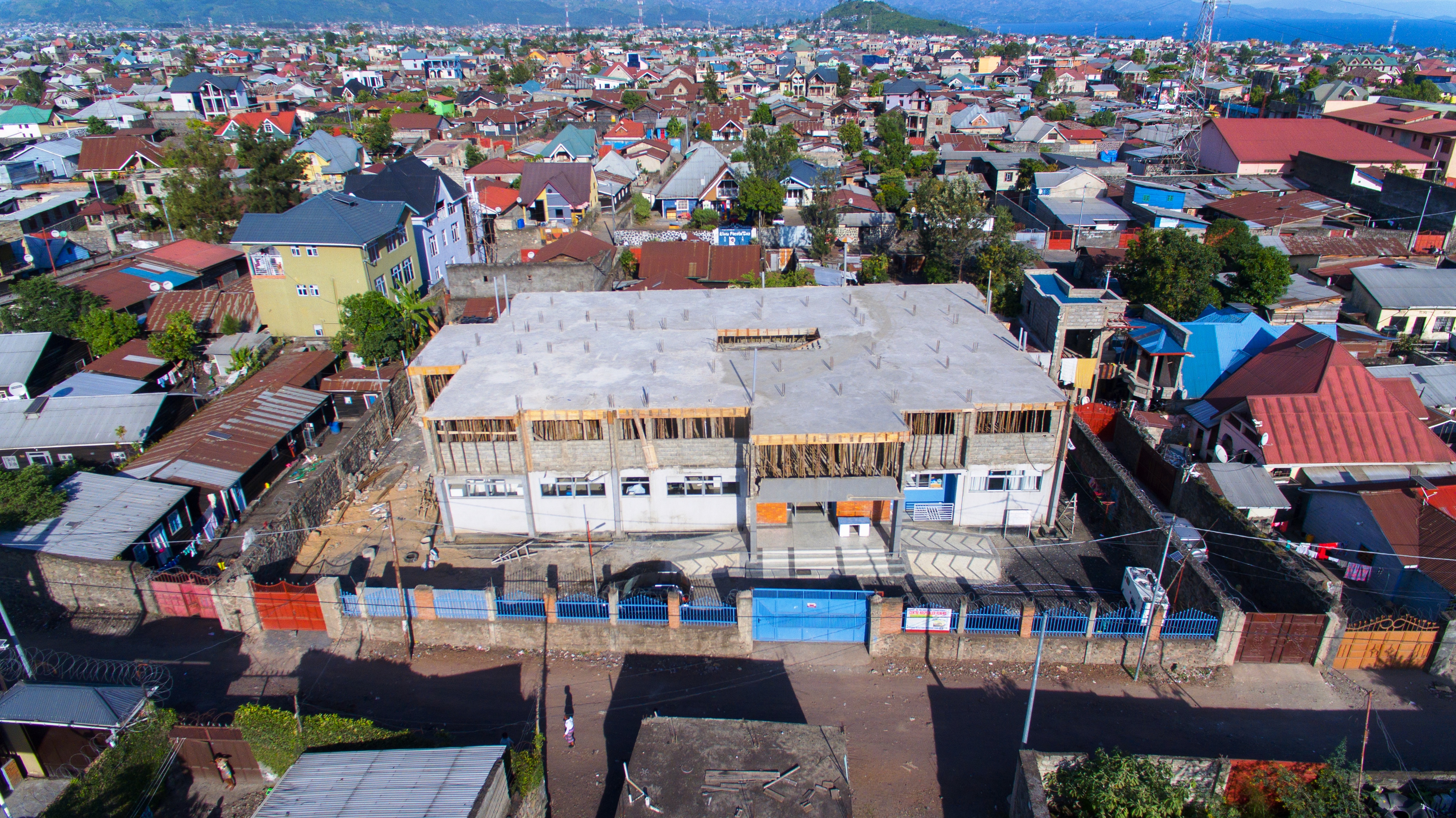
The situation in summer 2023, with the villas of the rich behind it and Lake Kivu in the background.
The slums are located north of the hospital: the water vendors bring the unfiltered water from the lake in the yellow canisters to this area.


The present hospital with its five functional departments: surgery, gynecology, general medicine (X-ray and ultrasound), internal medicine, and pediatrics.
After 28 years of experience with the Nepal Hospital founded by Interplast Germany (www.nepalhospital.de), the most important requirement is the reliability and commitment of the local doctors in this country of 100 million inhabitants, which is characterized by difficult conditions and forgotten by the West.
The planned large entrance and waiting hall was unfortunately obstructed by columns. They could not be persuaded to change the dark blue color: one would see the blood splatters and dead midges on it less. The diseases treated by the ambulance now and in the future are the infectious diseases malaria, typhoid fever (salmonella), gastritis and urinary tract infections.

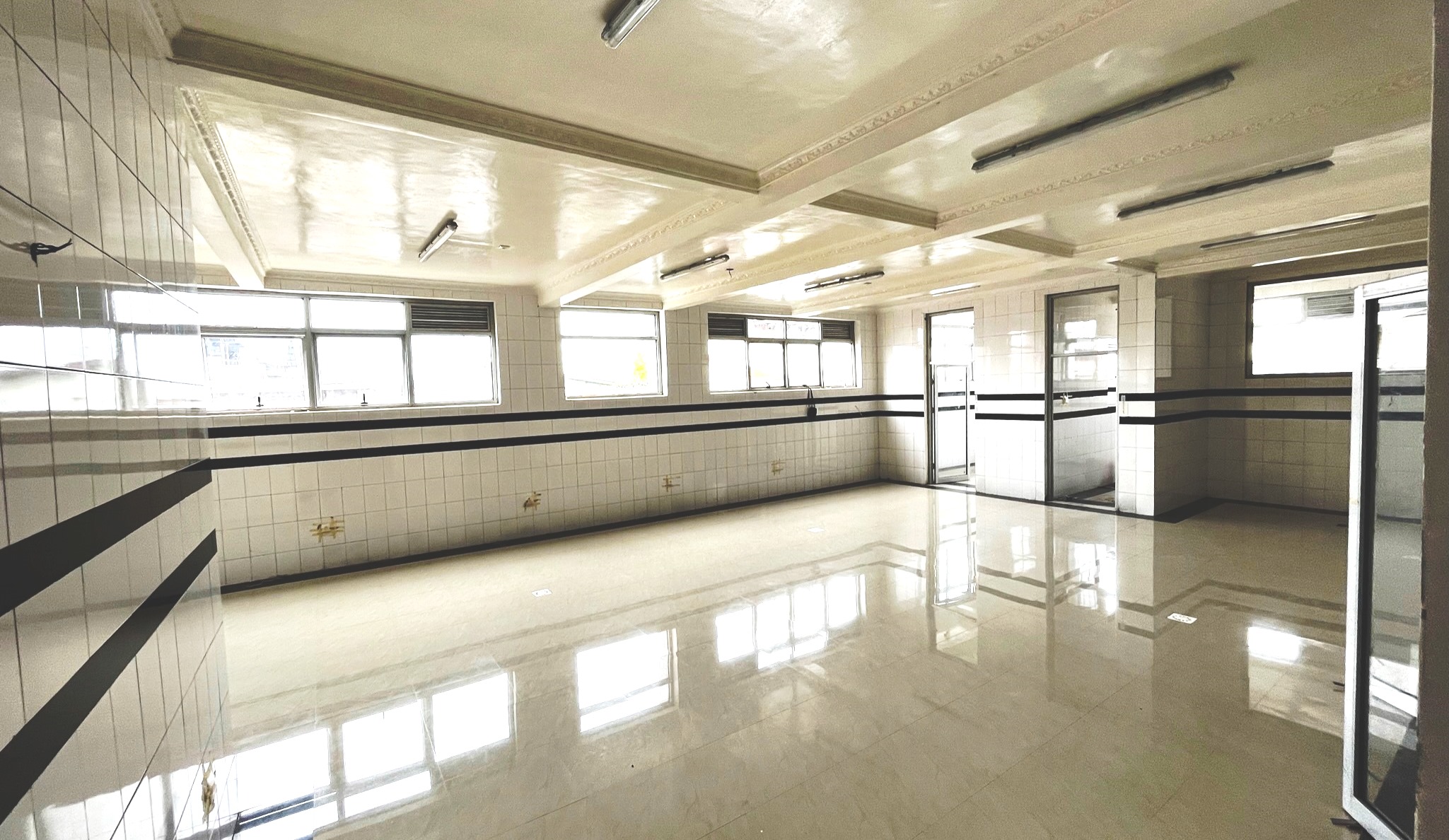
After completion of the reconstruction, surgical cases will also be treated (hernias, peritonitis, prostatic hypertrophy, goitre, hyperthyroidism and plastic surgery as well as gynaecological diseases and obstetric interventions). Here, too, the need is enormous. About 1% of Congolese with tumors and burn sequelae require plastic and reconstructive treatment – the catchment area of North and South Kivu covers a total of 12 million inhabitants. Likewise, western Rwanda and all of Burundi can benefit from the planned specialized hospital.
B. Departments
Surgery

The operating theater is the heart of the hospital: it is large enough for three teams to operate in at the same time.
Laboratory with the most modern analyzers, centrifuges and bacteriological incubators from China

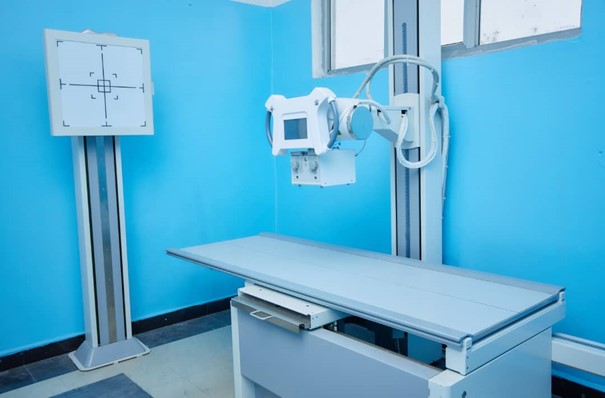
The high-performance X-ray machine surrounded by lead wallpaper, ...
... an ultrasound machine for the chest and abdomen, and a color Doppler for pregnant women will later become the main sources of income from paying patients.
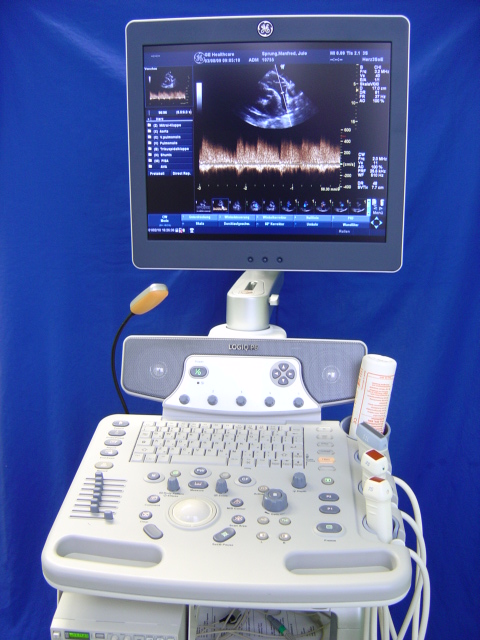

6 patient monitors to monitor patients undergoing surgery and emergencies. A defibrillator is invaluable, especially in Africa with its many sudden cardiac deaths.
The pharmacy is a central room at the entrance and is also to be used by external customers.
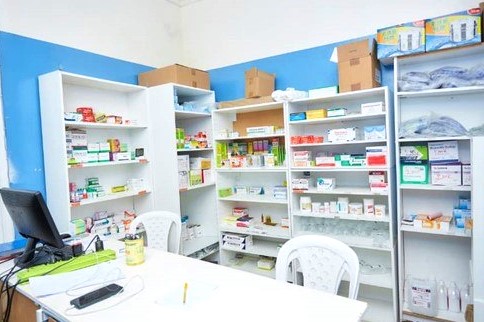
Patients operated on in Goma
Since 2015, seven surgical teams from INTERPLAST-Germany (www.interplast-germany.de) have very successfully operated on
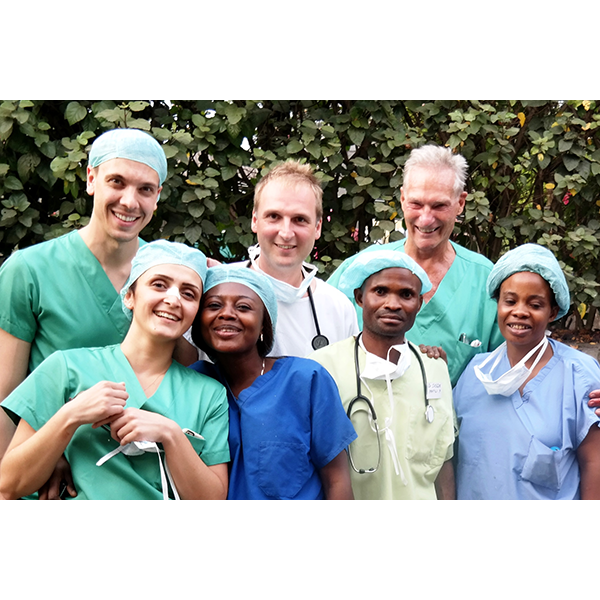
The INTERPLAST-Germany operations team 2018 at CEDIGO Hospital: Dr. Christoph Sachs, Dr. Katja Kassem-Trautmann, anesthetist Dr. Carsten Schröder
nurse Cynthia, anesthetist Jason, nurse Colette
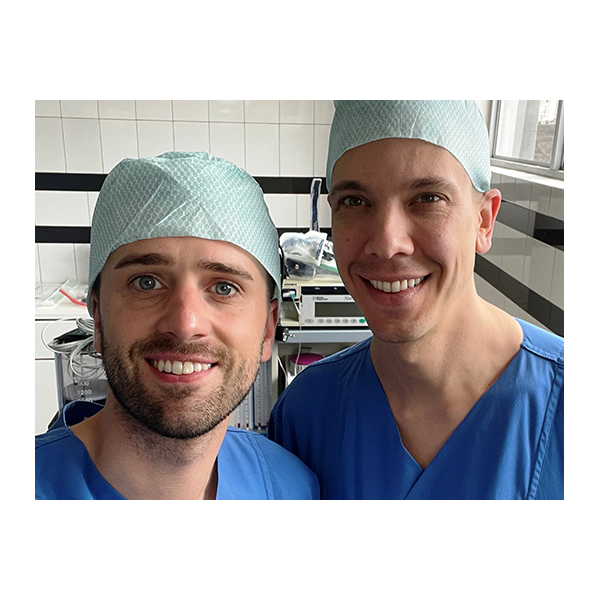
The INTERPLAST-Germany team under Dr. Christoph Sachs and his anesthetist Dr. Phillip Kloss from Berlin in 2022 and 2023
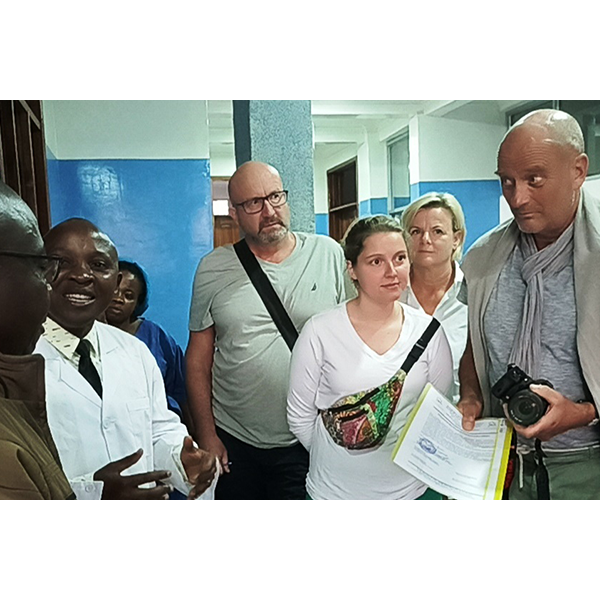
The INTERPLAST-Germany team 2023 under Prof. Peter Sieg and anesthetist Dr. Jens Hennike from Lübeck
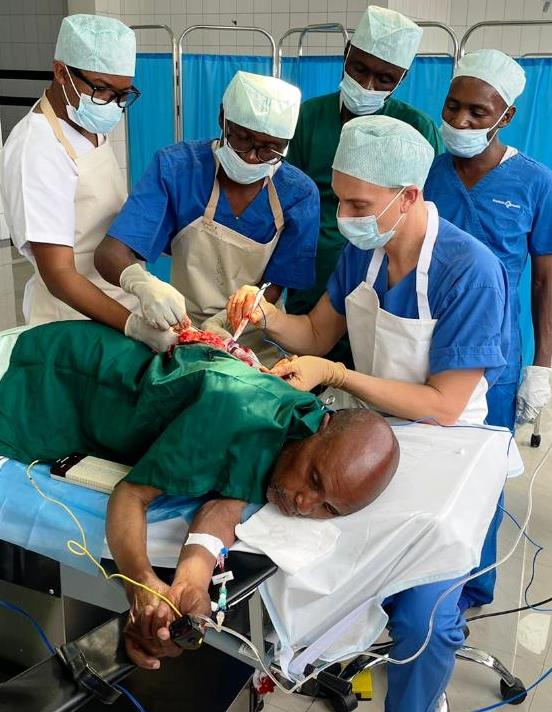
Dr. Christoph Sachs explains the electrocautery to the students.
Goma is located on a plateau in the middle of Africa, far away from the sea with its iodine content. That is why there are a large number of goiters there. After our Interplast team's flight home, we were able to persuade Dr. Kimona, who was always actively involved in the operations, to operate on a further 10 to 20 patients with extensive “strums” and keloids for a fee. As the latter patients come to us for cosmetic reasons, they are charged a small fee for the use of the surgery.
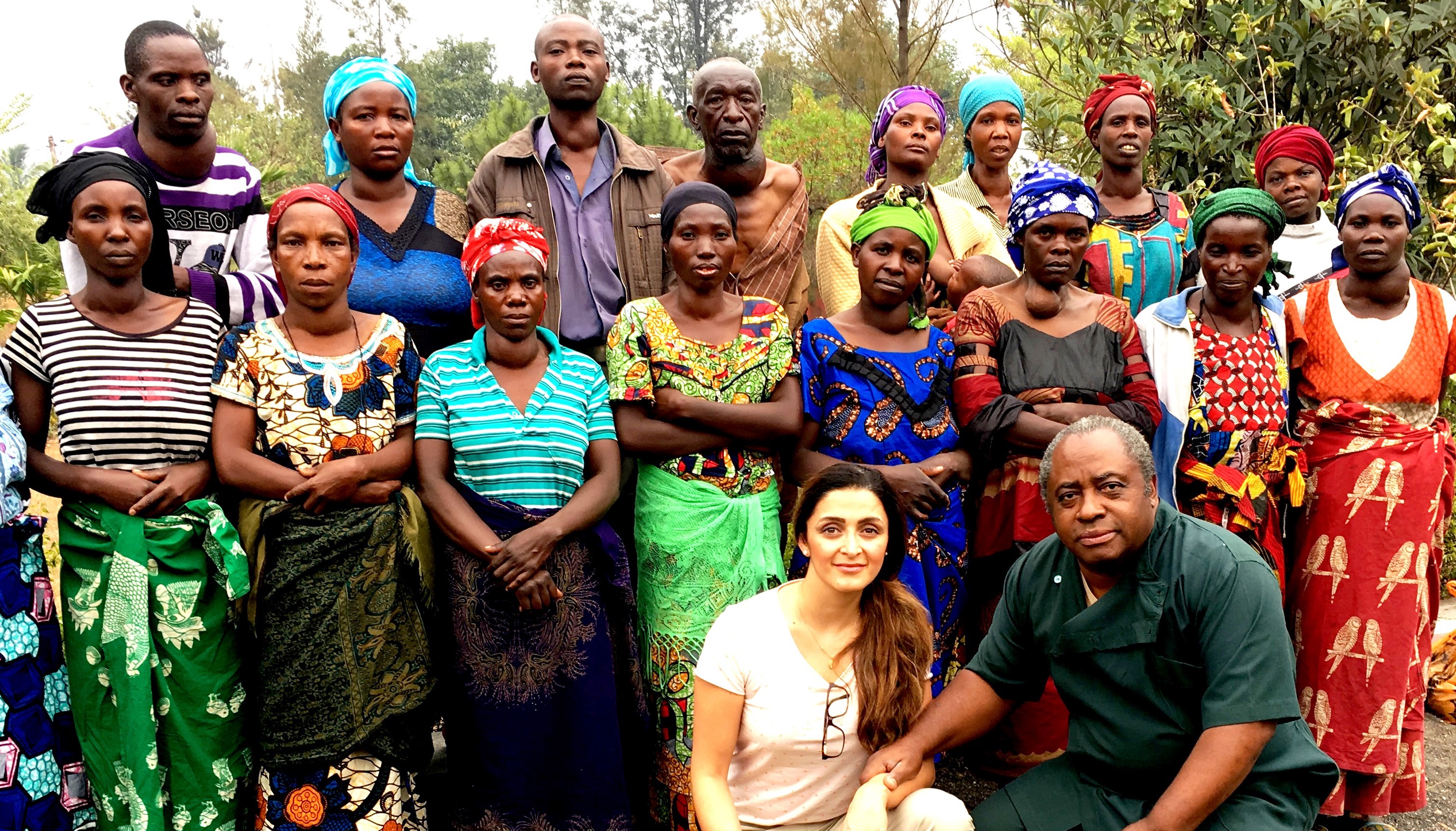
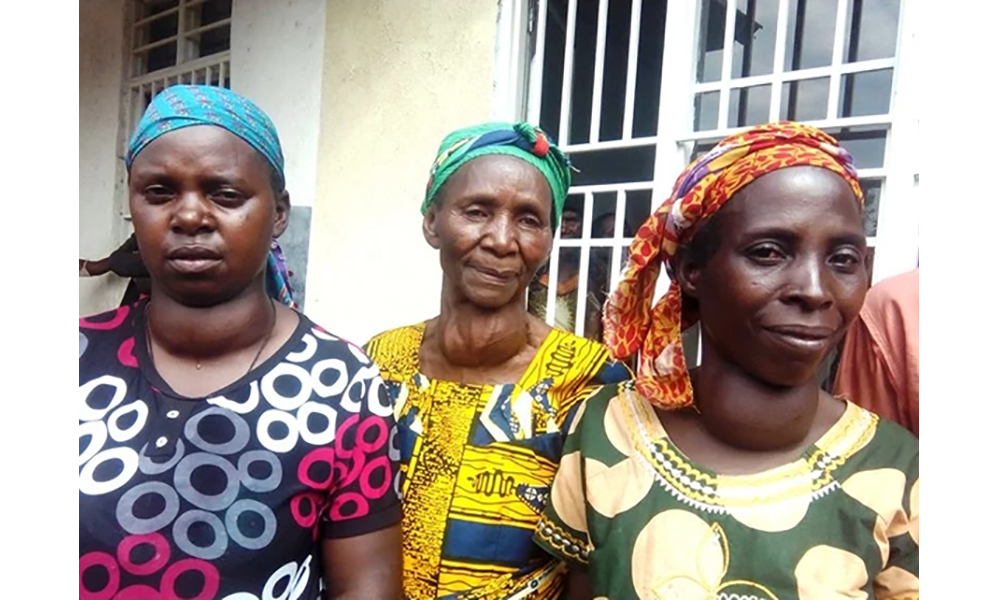
Because no Interplast team will be able to reach the safety of Goma in 2024 due to the rebels 70 km away, the hospital will organize a camp for Dr. Demongawi where he will only operate on poor patients with goiters.
Black skin tends to develop excessive scars and scar tumors (keloids). In young women, they occur particularly frequently after piercing the ears with impure needles or broken glass.
In this patient, the keloid has grown extremely over 6 years, but has not returned after the sterile operation. These common keloids are also surgically removed by local doctors
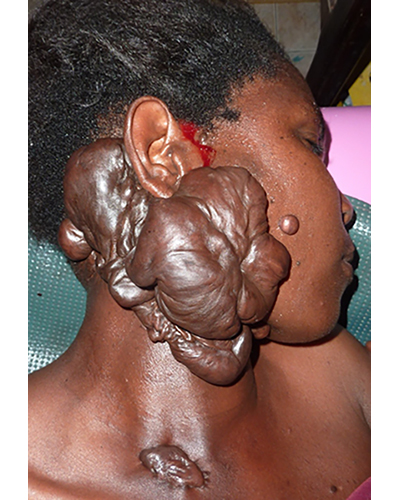
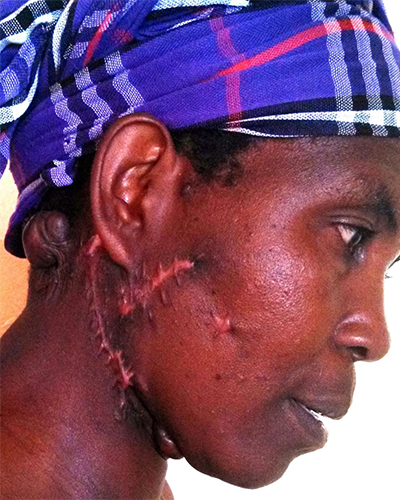
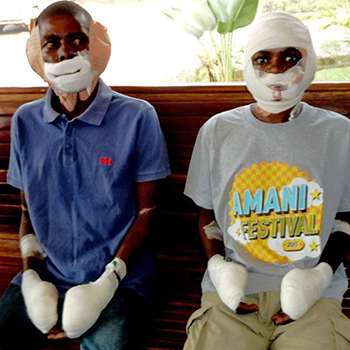
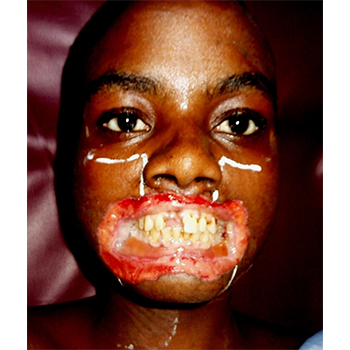
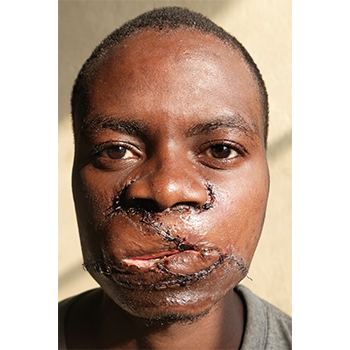
Two gold miners, who had all their fingers and ears “surgically” severed one after the other by the rebels, until the rebels found the nuggets in their hut – and then cut off both of their lips so that they would never lie again...
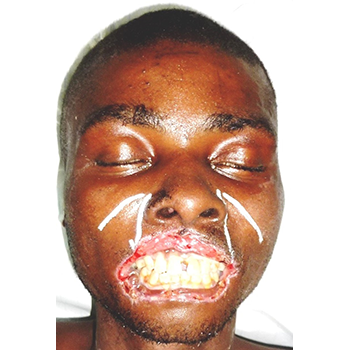
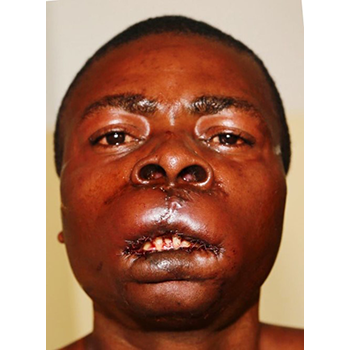
Hydrocephalus, a condition in which a tube is placed from the brain to the abdominal cavity in a neurosurgery procedure in Kampala, Uganda, where the excess cerebral fluid (liquor) is reabsorbed. This stops the pressure on the brain – and the widely spaced skull bones (calvaria) slowly find each other again.
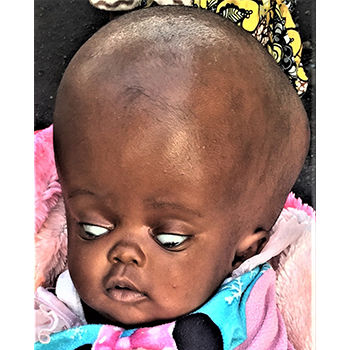
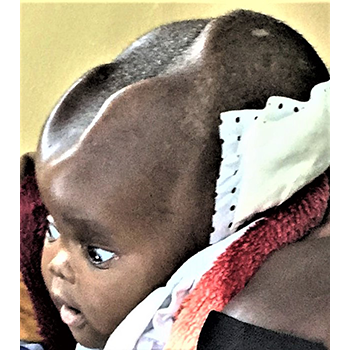
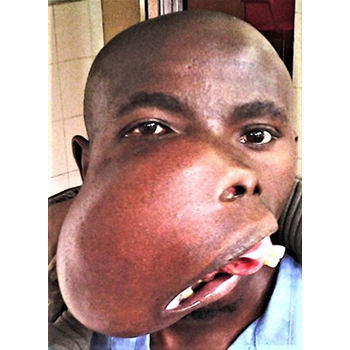
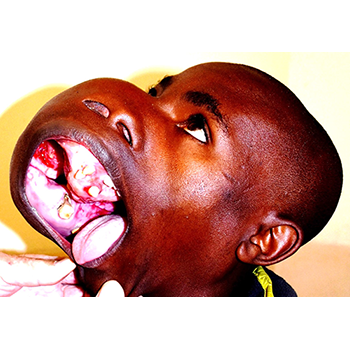
“Hippoman”, as he was called in Goma, had developed a huge tumor in his right upper jaw that no local surgeon dared to operate on.
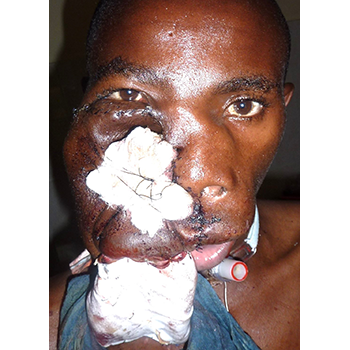
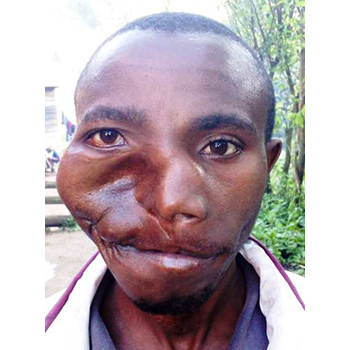
After radical resection, we used a composite pedicle to attach the 5th right rib to the pectoralis major muscle and thus reconstruct the right upper jaw over a metal splint.
“Elephant foot” of a young woman: tiny worms (filariae) in a river penetrate the skin between the toes and slowly clog all the lymph vessels of the lower leg.
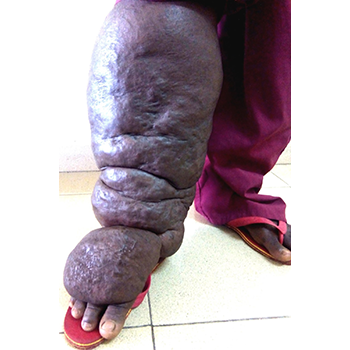
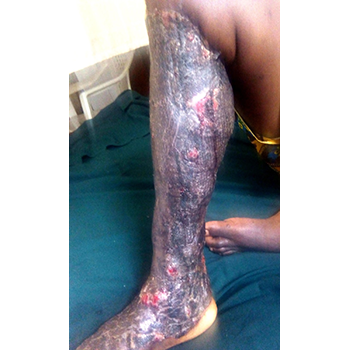
Dr. Sachs removed all the affected skin down to the muscles and covered the muscles with retina from the thigh, with a great result!

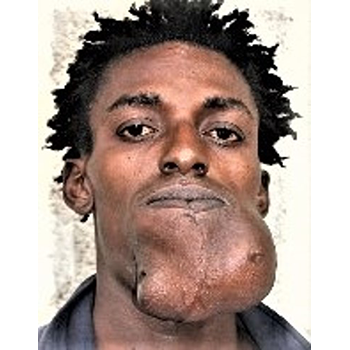
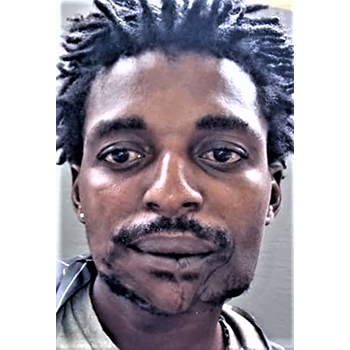
Recurrence of a benign tumor of the lower jaw (ameloblastoma), which originated in a tooth bud. Radical resection and reconstruction of the left lower jaw with a metal plate so that he can still chew on the right.
Benign tumor on the upper jaw, which could be removed relatively easily in toto. The patient fled on the 5th day for fear of having to pay for the operation...
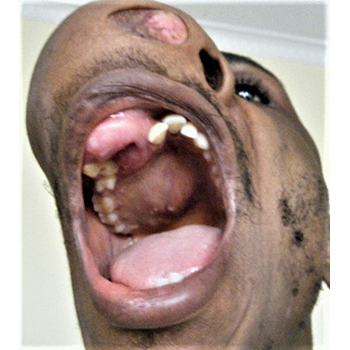
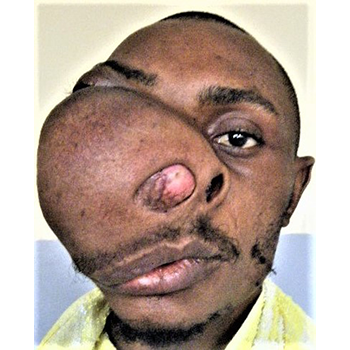
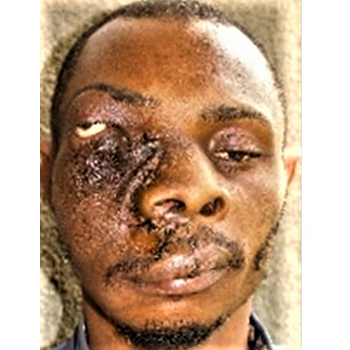
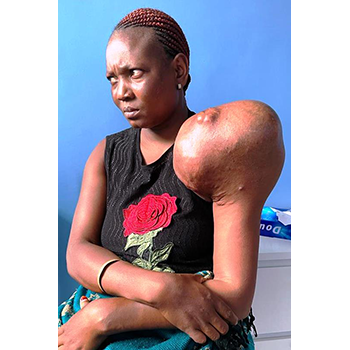
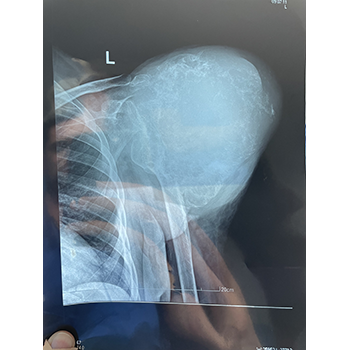
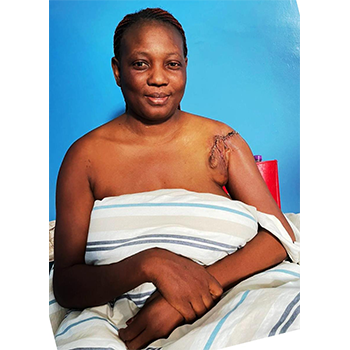
Malignant bone tumor of the humerus (chondro-osteosarcoma), which Dr. Sachs was able to remove completely while preserving the nerves to the left forearm and hand, so that the woman can continue to hold objects with them.
Potentially malignant tumor of the lower jaw that may have originated from a tooth. Prof. Sieg removed the tooth radically and replaced the left lower jaw with a metal splint so that the young man can chew on the right side.
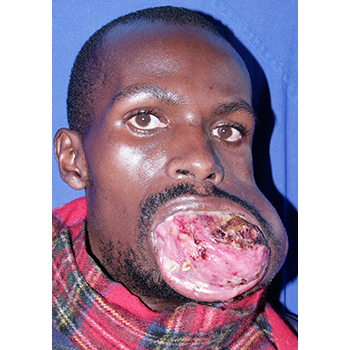
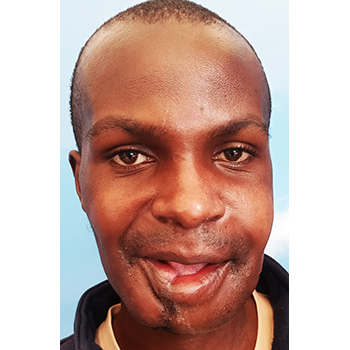
Gynecology and pediatrics

The first floor is now fully equipped with 30 beds, a perfect caesarean section operating room and a state-of-the-art premature birth department. On the right are the functional rooms for consultations, birth and caesarean section operations, on the left the patient rooms, at the back for women, at the front for children.
The girlfriend of my son Stefan Lemperle in San Diego, CA, who died in 2023, Tessa Page, is the chairwoman of the “UNITED INTERNET FOR UNICEF” foundation in Cologne. Tessa was aware of the high maternal and infant mortality rate in Congo and the need to establish a department for women and children at REHEMA Hospital, and immediately donated $200,000 through UNICEF-Germany. The heartfelt gratitude of all current and future patients - and mine - is assured to Tessa Page.
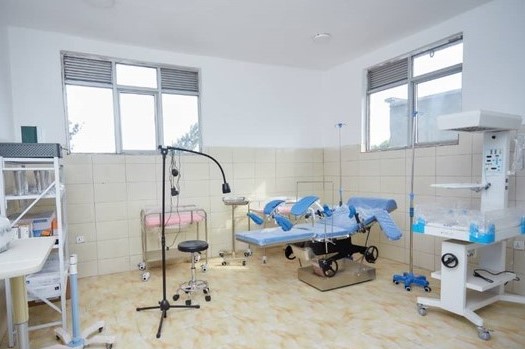

The neonatal unit has the most modern equipment from China: all resuscitation equipment such as vein finders, infant monitors, bubble ventilation, radiant warmers, phototherapy – and is supposed to attract endangered and cautious mothers with it.
Here, poor pregnant women can give birth to their children free of fear and with the best possible care, while better-off women receive all the amenities and medical advances in childbirth for an affordable fee. Family planning in our sense is unknown; on the contrary, our current gynaecologist Dr. Aimé Manga is a specialist in fertility therapy. 50% of people in Congo are under the age of 15 - and hardly any of these children have the prospect of working later in life.

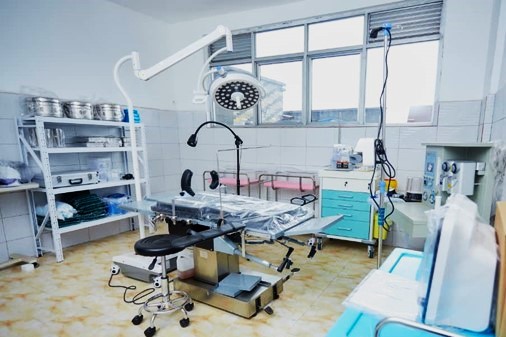
In June 2024, the 1st floor for women and children was completed at a cost of $200,000. A container from China brought 30 beds and state-of-the-art equipment for birth monitoring and neonatology.
B. Departments
Surgery

The operating theater is the heart of the hospital: it is large enough for three teams to operate in at the same time.
Laboratory with the most modern analyzers, centrifuges and bacteriological incubators from China


The high-performance X-ray machine surrounded by lead wallpaper, ...
... an ultrasound machine for the chest and abdomen, and a color Doppler for pregnant women will later become the main sources of income from paying patients.


6 patient monitors to monitor patients undergoing surgery and emergencies. A defibrillator is invaluable, especially in Africa with its many sudden cardiac deaths.
The pharmacy is a central room at the entrance and is also to be used by external customers.

Patients operated on in Goma
Since 2015, seven surgical teams from INTERPLAST-Germany (www.interplast-germany.de) have very successfully operated on

The INTERPLAST-Germany operations team 2018 at CEDIGO Hospital: Dr. Christoph Sachs, Dr. Katja Kassem-Trautmann, anesthetist Dr. Carsten Schröder
nurse Cynthia, anesthetist Jason, nurse Colette

The INTERPLAST-Germany team under Dr. Christoph Sachs and his anesthetist Dr. Phillip Kloss from Berlin in 2022 and 2023

The INTERPLAST-Germany team 2023 under Prof. Peter Sieg and anesthetist Dr. Jens Hennike from Lübeck

Dr. Christoph Sachs explains the electrocautery to the students.
Goma is located on a plateau in the middle of Africa, far away from the sea with its iodine content. That is why there are a large number of goiters there. After our Interplast team's flight home, we were able to persuade Dr. Kimona, who was always actively involved in the operations, to operate on a further 10 to 20 patients with extensive “strums” and keloids for a fee. As the latter patients come to us for cosmetic reasons, they are charged a small fee for the use of the surgery.


Because no Interplast team will be able to reach the safety of Goma in 2024 due to the rebels 70 km away, the hospital will organize a camp for Dr. Demongawi where he will only operate on poor patients with goiters.
Black skin tends to develop excessive scars and scar tumors (keloids). In young women, they occur particularly frequently after piercing the ears with impure needles or broken glass.
In this patient, the keloid has grown extremely over 6 years, but has not returned after the sterile operation. These common keloids are also surgically removed by local doctors





Two gold miners, who had all their fingers and ears “surgically” severed one after the other by the rebels, until the rebels found the nuggets in their hut – and then cut off both of their lips so that they would never lie again...


Hydrocephalus, a condition in which a tube is placed from the brain to the abdominal cavity in a neurosurgery procedure in Kampala, Uganda, where the excess cerebral fluid (liquor) is reabsorbed. This stops the pressure on the brain – and the widely spaced skull bones (calvaria) slowly find each other again.




“Hippoman”, as he was called in Goma, had developed a huge tumor in his right upper jaw that no local surgeon dared to operate on.


After radical resection, we used a composite pedicle to attach the 5th right rib to the pectoralis major muscle and thus reconstruct the right upper jaw over a metal splint.
“Elephant foot” of a young woman: tiny worms (filariae) in a river penetrate the skin between the toes and slowly clog all the lymph vessels of the lower leg.


Dr. Sachs removed all the affected skin down to the muscles and covered the muscles with retina from the thigh, with a great result!



Recurrence of a benign tumor of the lower jaw (ameloblastoma), which originated in a tooth bud. Radical resection and reconstruction of the left lower jaw with a metal plate so that he can still chew on the right.
Benign tumor on the upper jaw, which could be removed relatively easily in toto. The patient fled on the 5th day for fear of having to pay for the operation...






Malignant bone tumor of the humerus (chondro-osteosarcoma), which Dr. Sachs was able to remove completely while preserving the nerves to the left forearm and hand, so that the woman can continue to hold objects with them.
Potentially malignant tumor of the lower jaw that may have originated from a tooth. Prof. Sieg removed the tooth radically and replaced the left lower jaw with a metal splint so that the young man can chew on the right side.


Gynecology and pediatrics

The first floor is now fully equipped with 30 beds, a perfect caesarean section operating room and a state-of-the-art premature birth department. On the right are the functional rooms for consultations, birth and caesarean section operations, on the left the patient rooms, at the back for women, at the front for children.
The girlfriend of my son Stefan Lemperle in San Diego, CA, who died in 2023, Tessa Page, is the chairwoman of the “UNITED INTERNET FOR UNICEF” foundation in Cologne. Tessa was aware of the high maternal and infant mortality rate in Congo and the need to establish a department for women and children at REHEMA Hospital, and immediately donated $200,000 through UNICEF-Germany. The heartfelt gratitude of all current and future patients - and mine - is assured to Tessa Page.


The neonatal unit has the most modern equipment from China: all resuscitation equipment such as vein finders, infant monitors, bubble ventilation, radiant warmers, phototherapy – and is supposed to attract endangered and cautious mothers with it.
Here, poor pregnant women can give birth to their children free of fear and with the best possible care, while better-off women receive all the amenities and medical advances in childbirth for an affordable fee. Family planning in our sense is unknown; on the contrary, our current gynaecologist Dr. Aimé Manga is a specialist in fertility therapy. 50% of people in Congo are under the age of 15 - and hardly any of these children have the prospect of working later in life.


In June 2024, the 1st floor for women and children was completed at a cost of $200,000. A container from China brought 30 beds and state-of-the-art equipment for birth monitoring and neonatology.
Future Departments of Internal Medicine and Orthopaedics

Should the need and corresponding funding opportunities arise in the future to set up an internal and an orthopaedic department, two more floors can be added to the existing two.
Administration
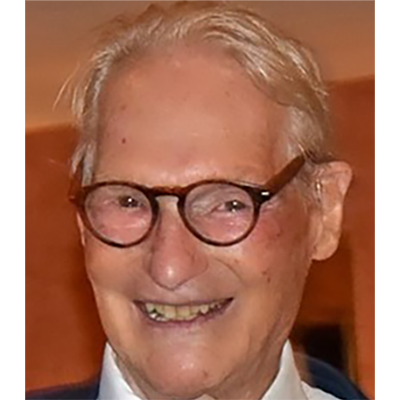
Prof. Gottfried Lemperle
Organizer
Plastic surgeon in Frankfurt/Main, Germany
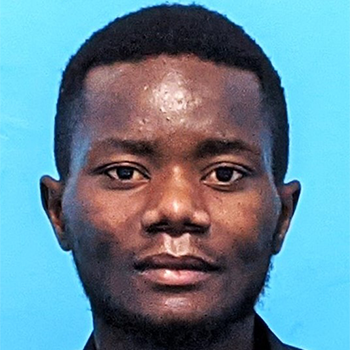
MBA
Fidele Baluma
Financial Officer and Manager
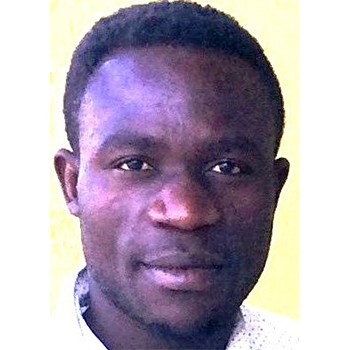
Lawyer
Gustave Riziki
REHEMA's legal advisor
The doctors at the hospital
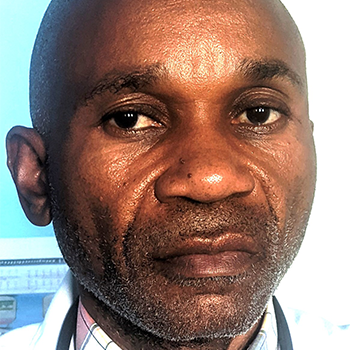
Dr. Voté
General practitioner, ultrasound and X-ray
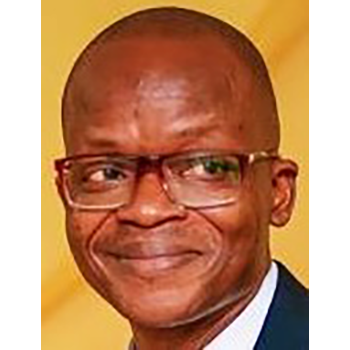
Dr. Richard Demongawi
General surgeon from the University of Kinshasa
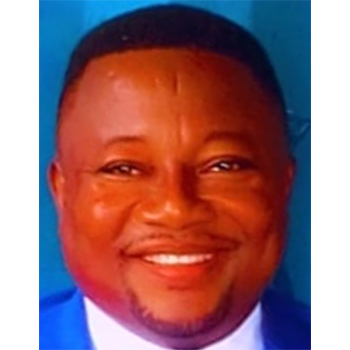
Dr. Aimé Manga
Medical Director and gynaecologist at Kindu University
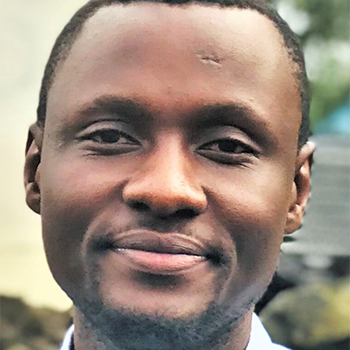
Dr. Salomon Kabeza
Surgical assistant
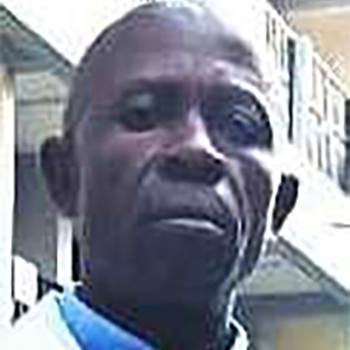
Dr. Jean Bakuka
Internist
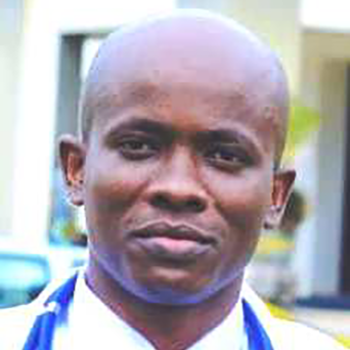
Dr. Olivier Wakaungu
Doctor and pediatrician
REHEMA staff
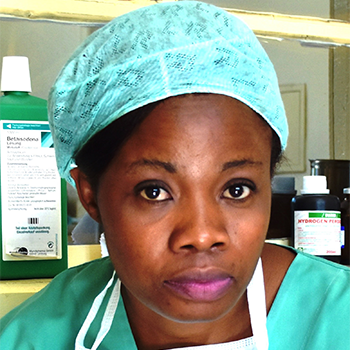
Mme. Colette
Head of the operating room

M. Dieudonne
Head of the nursing service
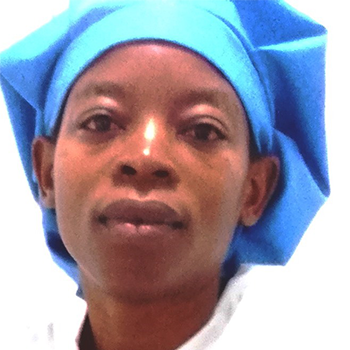
Mme. Dorcas
Midwife
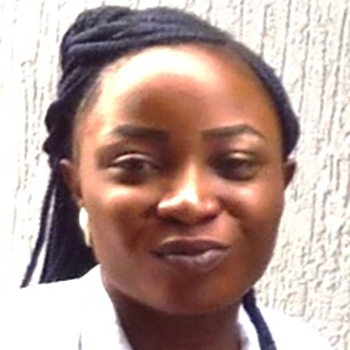
Mme Judite
Laboratory
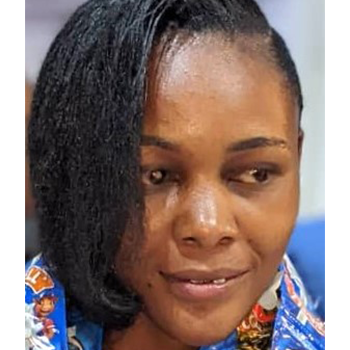
Mme Leontine
Graduated pharmacist
PARTNER & Sponsors of the project

“INTERPLAST Germany - a non-profit association for plastic surgery in developing countries” was founded in 1980 by Prof. Lemperle. The association takes care of needy patients worldwide with plastic surgery problems such as burns, malformations and tumors and brings patients with difficult disfigurements to Germany.
Under the current chairman Dr. André Borsche, head physician for plastic surgery in Bad Kreuznach, Interplast-Germany has grown into an organization that sends out around 70 teams every year to operate on around 4,000 patients.

“Church in Action” in Frankfurt also sends work teams to schools, refugee camps, homeless people, etc. all over the world and supports the Goma Hospital by sending volunteer specialists, among other things.
The founder and pastor is Cris Zimmermann. His grandfather Dr. Richard Zanner founded the Zanner Institute, the first private Christian secondary school in Goma, in 1992 under the care of the “Church of the Nazarene”.
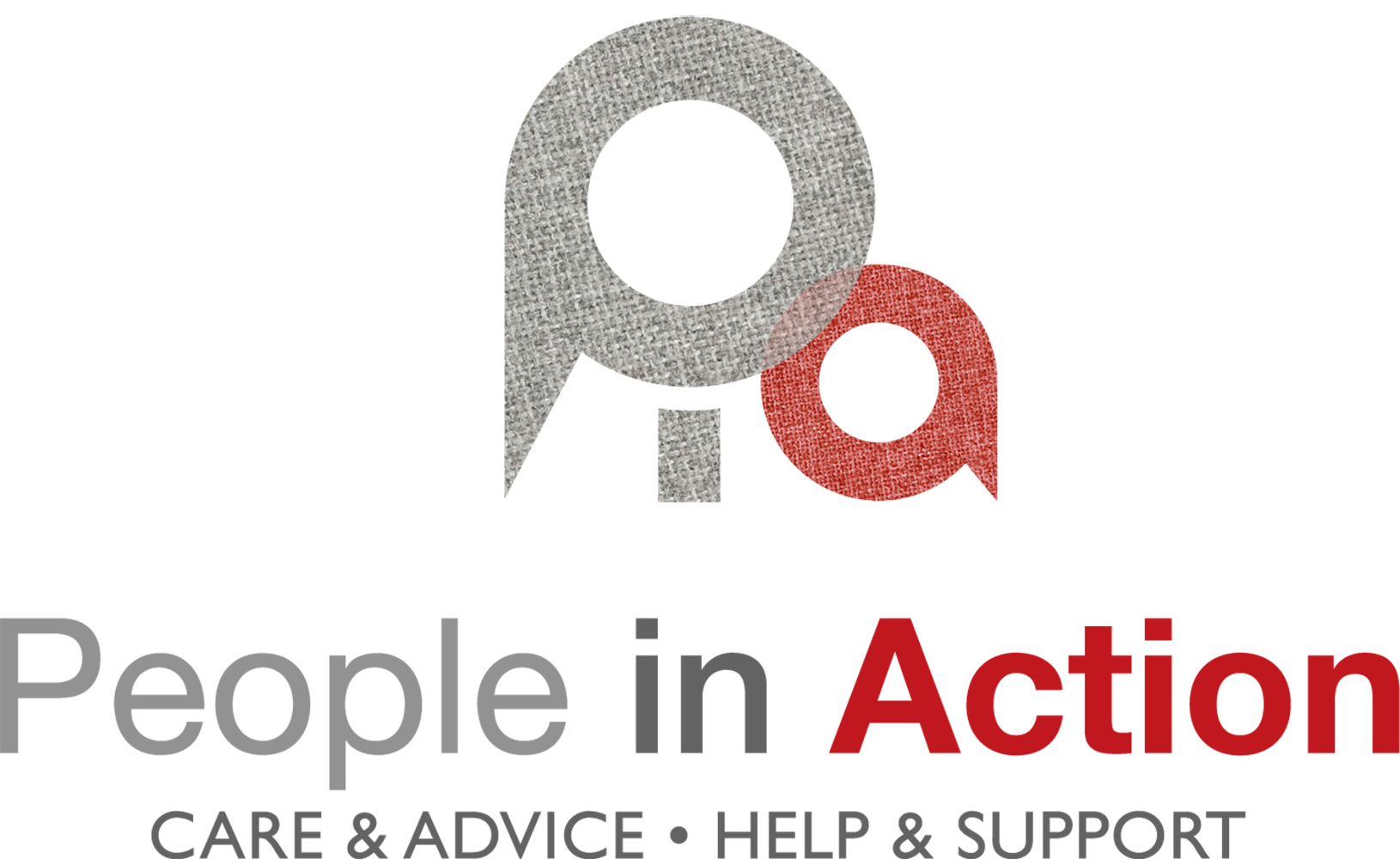
The organization “People-in-Action International” (PAI) was founded in 2001 as a non-profit association and takes care of knowledge and street children. PAI is also committed to helping women and girls who have been victims of violence and provides psychosocial and economic assistance.
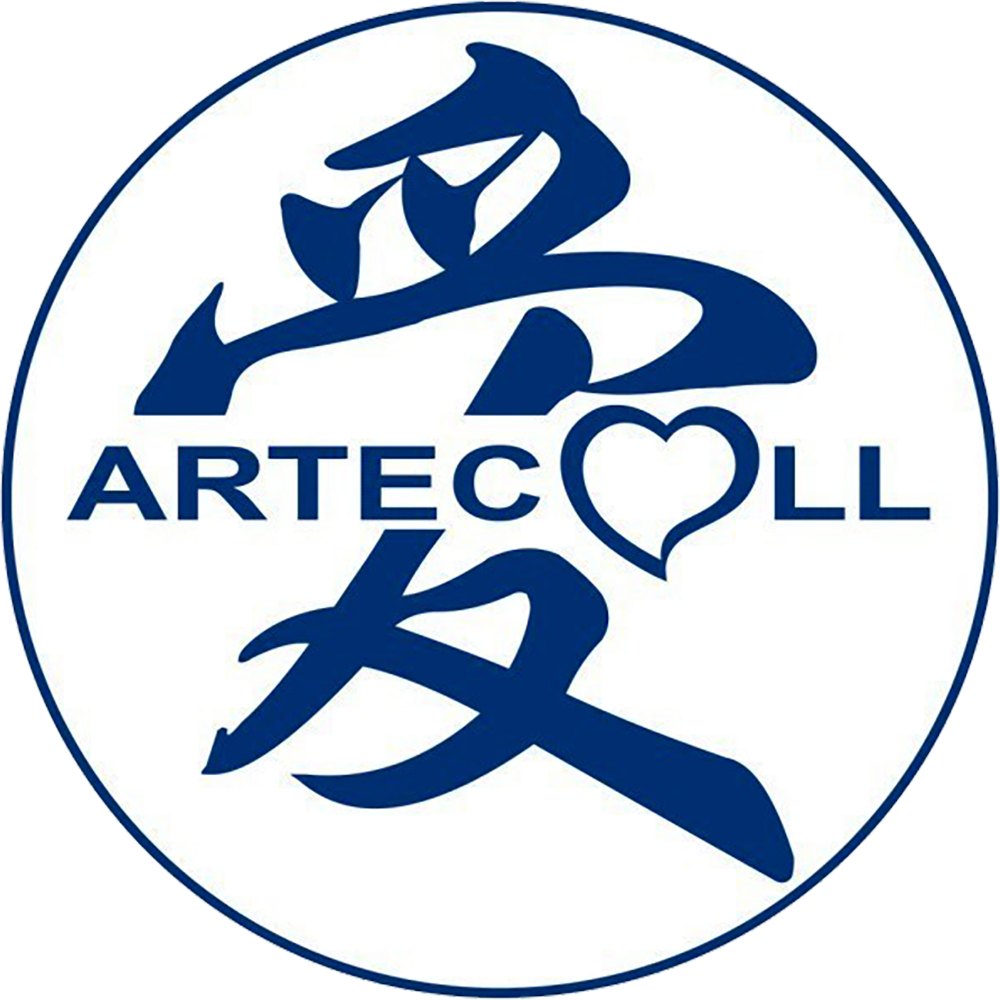
Hafod produces the permanent wrinkle treatment Artecoll (Chinese: ABEIFU) developed by Prof. Lemperle in Holland and has been selling it very successfully in China since 2002. The owner Dr. Edmund Wang and his CEO Miss Jolee generously support the hospital with monthly donations.

MSP Concept GmbH & Co KG, based in Berlin, Germany, manufactures urological products under the PeniMaster brand. Its CEO Matthias Suchy has scientific ties to Prof. Lemperle and is also a generous permanent donor.
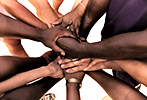
Ten permanent German donors ensure that the poor in Goma can be treated free of charge at the REHEMA hospital at all times.
Dr. med. Martin Lemperle has financed the first floor of the hospital and the studies or workshops of almost 200 polio-disabled young people.
REHEMA Financiers
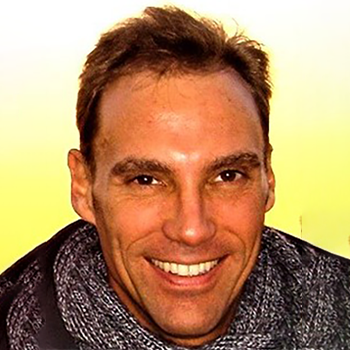
Dr. Martin Lemperle
FormMed Healthcare,
Frankfurt/Main
Principal Financial Backer
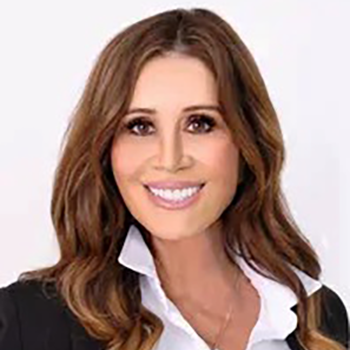
RA Tessa Page
Chairwoman of United Internet for UNICEF
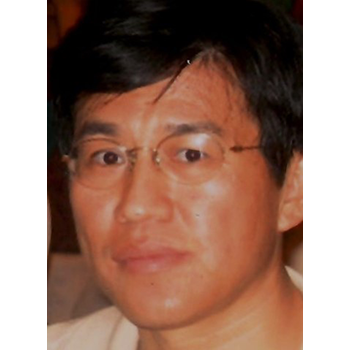
Dr. med. Edmund Wang
Owner Hafod Bioscience, B.V., Shanghai

Miss Jolee
CEO of Hafod Bioscience B.V.
in Shanghai
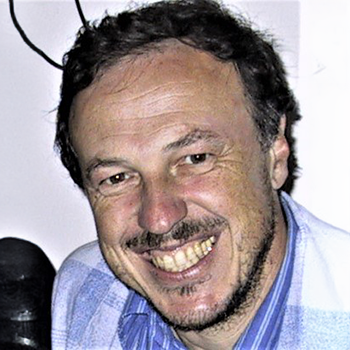
Dr. André Borsche
Chairman of INTERPLAST-Germany e.V.
REHEMA permanent donors

Matthias Suchy
MSP Concept
Berlin, Germany
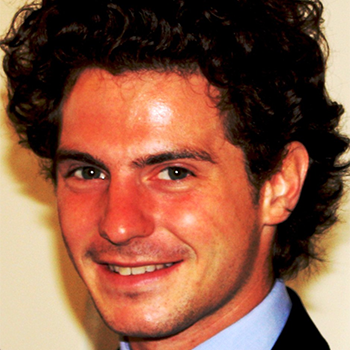
Dr. Arthur Charpentier
ENT Cologne
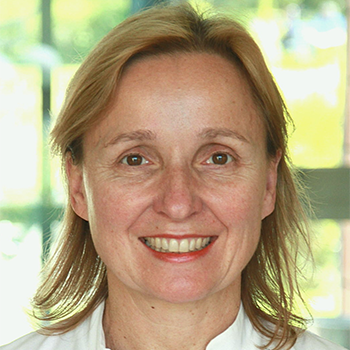
Prof. Dr. Jutta Liebau
Plastic Surgeon
Düsseldorf
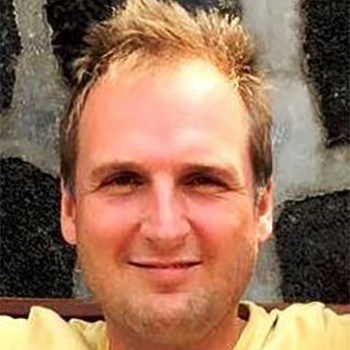
Dr. Carsten Schröder
Anesthetist, Horgen
Switzerland
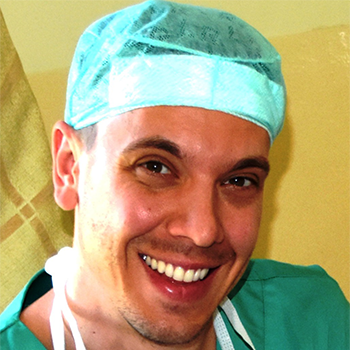
Dr. Christoph Sachs
Plastic Surgeon
Berlin, Germany
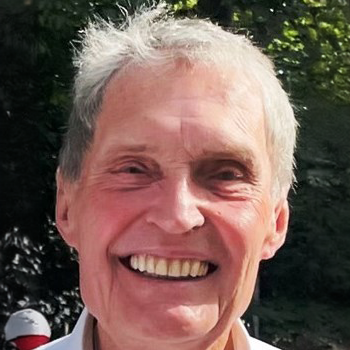
Hein Stahl
Retired General
Hennef, Germany
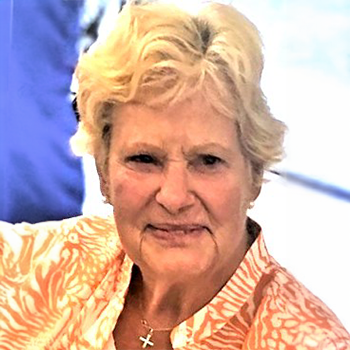
Veronika Horst
Retired Teacher
Kirchheim/Teck, Germany
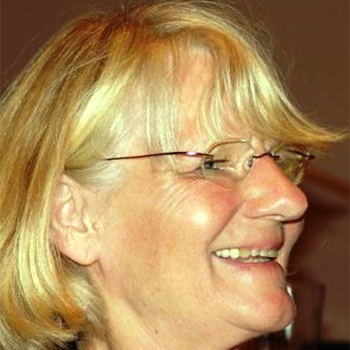
Regina Morasch
Retired Teacher
Esslingen, Germany

Christine Mellies
Maintal, Germany
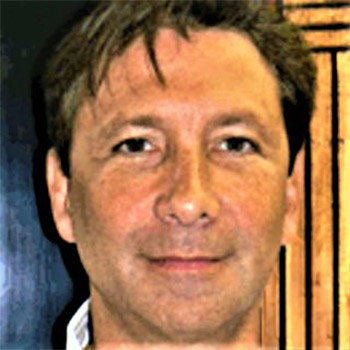
Dr. Gerald Pierone
Vero Beach (FL), USA
The hospital and the many disabled and needy students have so far been financed by private donations. The plan is to hand over the hospital completely to the government in 2025 to use it as a teaching hospital for the University of Goma (UNIGom) and for the training of young doctors. Hopefully further generous donations will be used for the free treatment of the poor – and this humanitarian task will be recorded in the contract with the government.
We thank the designer of the first website, my son-in-law Hans Jacob and Patricius Watola from Florida for the successful REHEMA logo. We also thank Peter and Anja Sersch from Rome for creating this website.
Financing of the REHEMA Hospitals in Goma, Congo
Due to the high bank fees in Congo and the changing exchange rates from € to $, only the transfers in US$ from the INTERPLAST account at the Kreissparkasse Cologne are shown here. The expenses in US$ in Congo are documented there and at GL to the exact $ amount, but for the reasons given above they often differ by 10%. However, they can be viewed at any time.
| # | Date | COSTS for construction and maintenance of the hospital | Sum |
|---|---|---|---|
| 1 | 11/2020 to 12/2022 | Ground floor, documents, architect, shell, plumbing, exterior structures, etc. | 520.000€ |
| 2 | 06/2022 | Container with IKEA furniture from Frankfurt + freight | 98.000€ |
| 3 | 11/2022 | Container with surgical equipment from China | 89.000€ |
| 4 | 06/2022 bis 06/2024 | Salaries for 15 employees approx. $5,500/month. | 190.000€ |
| 5 | 01/2023 to 06/2024 | 1st floor for gynecology and pediatrics Architect, shell, roof, plumbing, etc. |
215.000€ |
| 6 | 06/2024 | Containers from China, beds and equipment | 93.000€ |
| 1.200.000€ | |||
| 7 | Until 06/2024 | Study + craft + operations of disabled people | ca. 380.000€ |
| REVENUE from DONATIONS | 1.580.000€ | ||
| 1 | 03/2020 | Inheritance of Gottfried Lemperle | 150.000€ |
| 2 | 05/2020 | Dr. Martin Lemperle | 40.000€ |
| 3 | 2020 | begged from “friends and family” | 130.000€ |
| 4 | 2021 | Dr. Martin Lemperle | 40.000€ |
| 5 | 2022-2023 | INTERPLAST-Germany e.V. | 70.900€ |
| 6 | 2022 | Dr. Martin Lemperle | 150.000€ |
| 7 | 2022 - 2024 | B.Braun Foundation, Melsungen for 23 medical students | 72.000€ |
| 8 | 14.02.2022 | "Third Monday Foundation" by William Holmes 2x$10.000 |
20.000€ |
| 9 | 2022 | Fam. Karl, Bad Soden + Irmgard Jansen + Chistl Klöß | 19.500€ |
| 10 | 2023 | Dr. Martin Lemperle | 150.000€ |
| 11 | 13.04.2023 | Else-Kröner-Fresenius Stiftung | 40.000€ |
| 12 | 19.05.2023 | United Internet for UNICEF 1. Stock | 185.000€ |
| 13 | 2024 | Dr. Martin Lemperle | 330.000€ |
| ab 2021 | Permanent donors up to the status on June 30, 2024 | ||
| 14 | Seit 11/2021 | Hafod Bioscience, Shanghai 32 months. à $2,500 = $80,000 | 80.000€ |
| 15 | 11/2021 bis 30.06.2024 | Matthias Suchy, Berlin; Dr. Arthur Charpentier, Köln; Prof. Dr. Jutta Liebau, Düsseldorf; Dr. Carsten Schröder-Horgen, Schweiz; Dr. Christoph Sachs, Berlin; Hein Stahl, Hennef; Veronika Horst, Kirchheim/Teck; Regina Morasch, Esslingen, Christine Mellies, Maintal; Dr. Gerald Pierone, Vero Beach (FL), USA total 1,200 €/month |
30.000€ |
| 1.580.000€ |
FREE TREATMENTS FOR THE NEEDY

When traveling through Goma and the surrounding villages, I noticed the many disabled people who have to eke out an existence as beggars, sliding around on the floor and without wheelchairs or leg braces and operations.
All those with congenitally crippled lower legs would have preferred a wheelchair to a transtibial amputation with prostheses but being able to walk upright. Slowly, slowly.

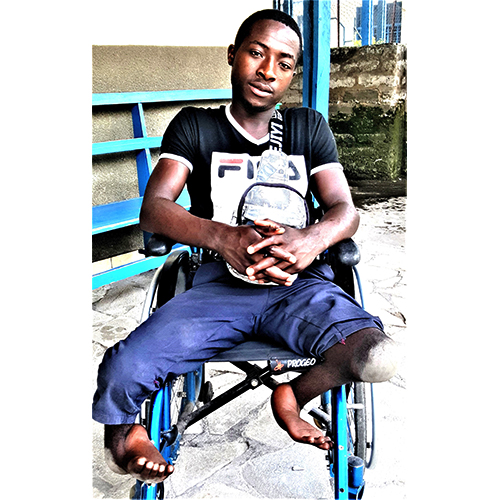

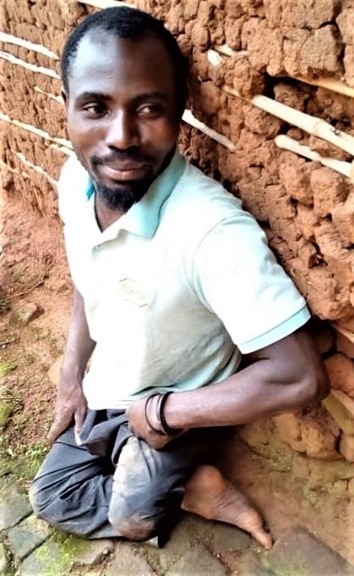
In a wheelchair that cost $150 from China, they are mobile and can look for a job selling phone cards or lottery tickets, etc.
His life will also change completely, from beggar to employee or salesperson.

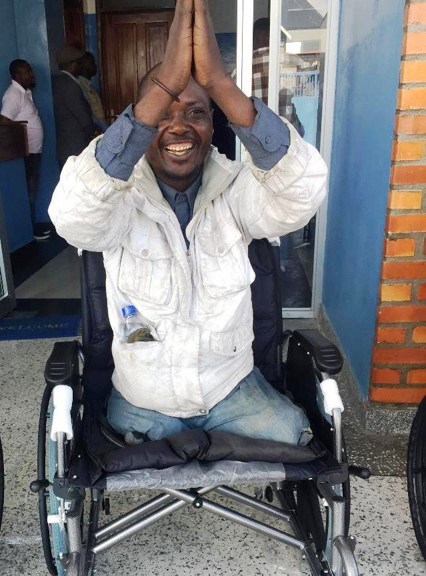
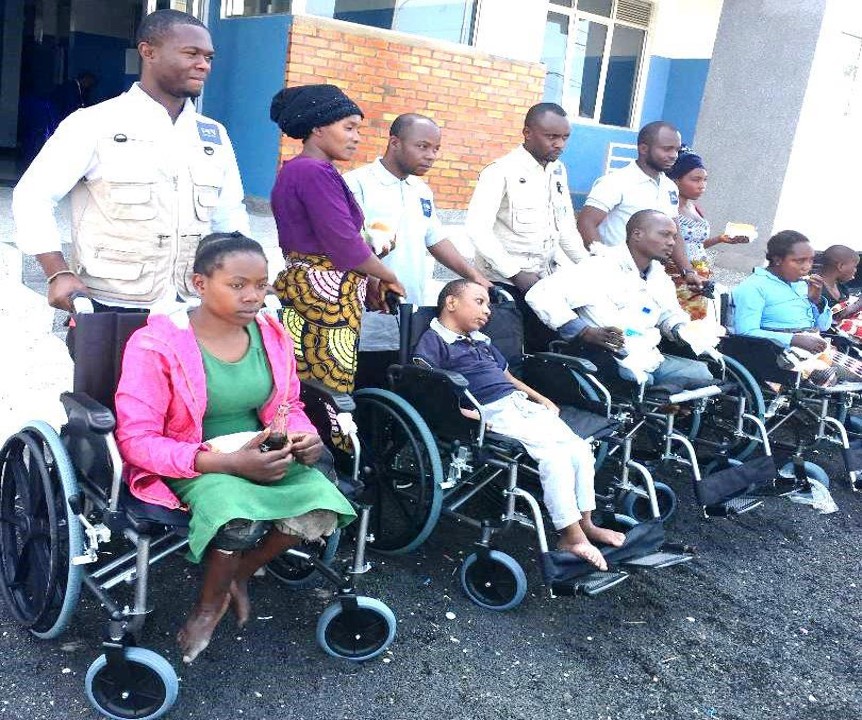
Distributing wheelchairs from China in front of the hospital. We had to take the wheelchair away from the mentally handicapped boy.
So far, we have been able to finance the education of more than 50 polio-paralyzed students to become public health officers, laboratory technicians, physiotherapists or computer specialists. In addition, around 50 healthy students with no financial means but with good high school diplomas were able to study nursing or midwifery, 25 of them with scholarships from the B.Braun Foundation in Melsungen.
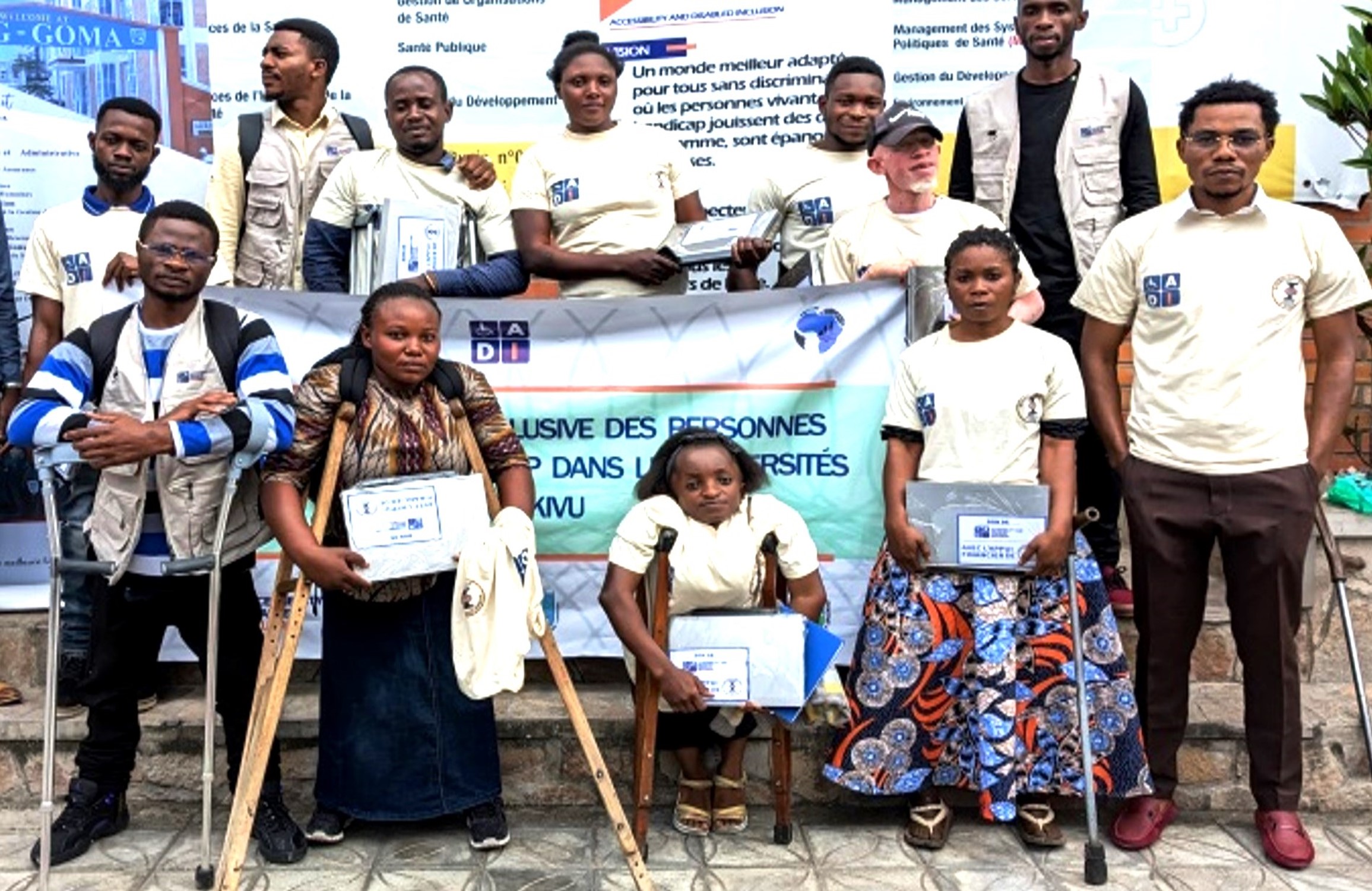
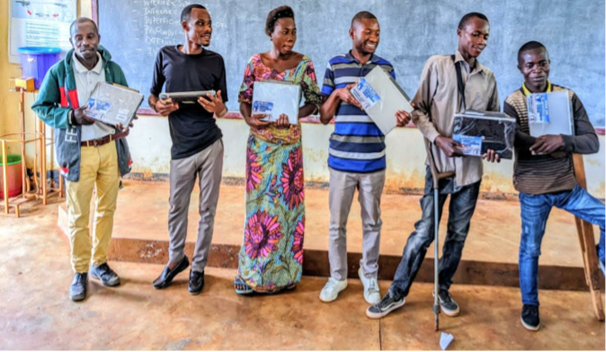
Disabled high school graduates were the first to receive a computer for their paramedical studies. By the end of 2025, they will all have passed their exams.
There are people in many villages in Congo who were born with fixed, right-angled knee joints that can be placed vertically on the legs with the help of an extension of the tendons behind the knee joint. They have never been introduced to an orthopedist because of poverty - and live their lives as beggars on the floor...
These two girls have either stiff knees or polio-paralyzed lower legs, but neither the family nor the teachers are committed to getting them treatment. Empathy seems to be unknown to the otherwise likeable Congolese.
Disabled persons scheduled for surgery
Hydrocephalus, in which the cerebral fluid (liquor) does not drain to the spinal cord. In this case, a drainage tube (shunt) must be placed to the abdominal cavity as a matter of urgency (see Fig. 2).
Here, the drainage runs over the right skullcap under the skin of the neck and chest into the abdominal cavity, where the continuously produced cerebral fluid is absorbed – which would otherwise occur in the spinal canal.
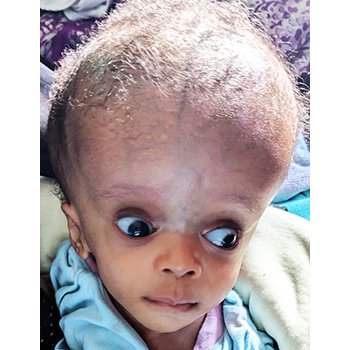

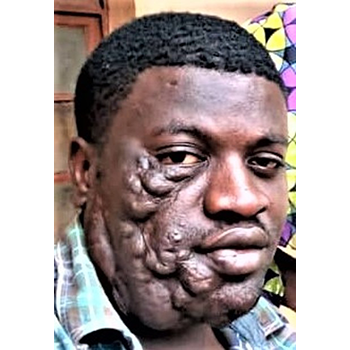
Venous tendril hemangioma that grows over many years and can probably only be removed step by step using long clamps.
Benign nerve tumor (neurofibroma) that has been growing slowly since birth and had to be reduced in size in a sub-radical manner in two major excisions in a courageous operation (because it is riddled with many tangles of arteries).
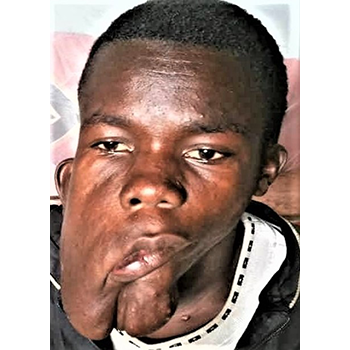
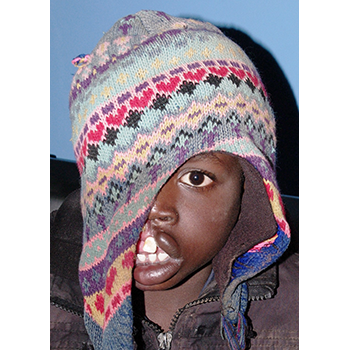

Noma is a disease that affects children and young people. It is caused by a bacterium “that has not yet been discovered!” but which attaches itself to millet awns in the gums and can cause an entire cheek or nose to disintegrate within a few days, accompanied by a high fever. Many children die from it; in others, the dead (necrotic) tissue falls out of the face in the following months, leaving these large defects.
The face of this young man has indeed shed the dead soft tissue, but the dead left upper jaw still has to be surgically removed. Then, at Noma Hospital in Niamey, Niger (www.noma.de), Dr. Andreas Schmidt from Murnau will reconstruct the upper jaw of both boys in a microsurgical operation lasting several hours, using a free “composite graft” from the shoulder blade. The pinnacle of plastic surgery!
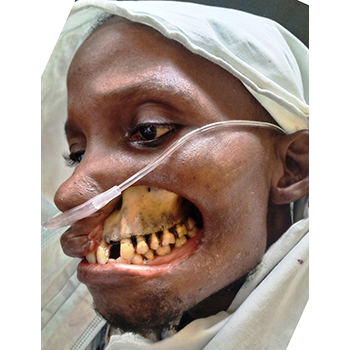
Support for the disabled in Goma
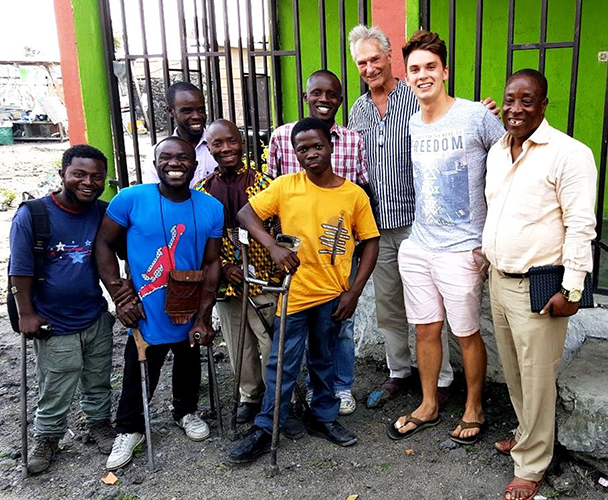
“We got to know and love the six 'Power Boys' during our operations in Goma between 2015 and 2018. With donations from our friends and family, they went on to study (from left to right) to become an NGO consultant, a lawyer, a customs officer, a shoemaker, a public health specialist and an orthopaedic surgeon. My grandson Dr. Johannes Schierle (a specialist in tropical medicine) and Reverend Balibanga, who took them off the streets and helped them complete their A-levels at the German Dr. Zanner Institute.
Text_F7: They had no chance after graduating from high school and lived by begging and in this hut from manioc potato cultivation...
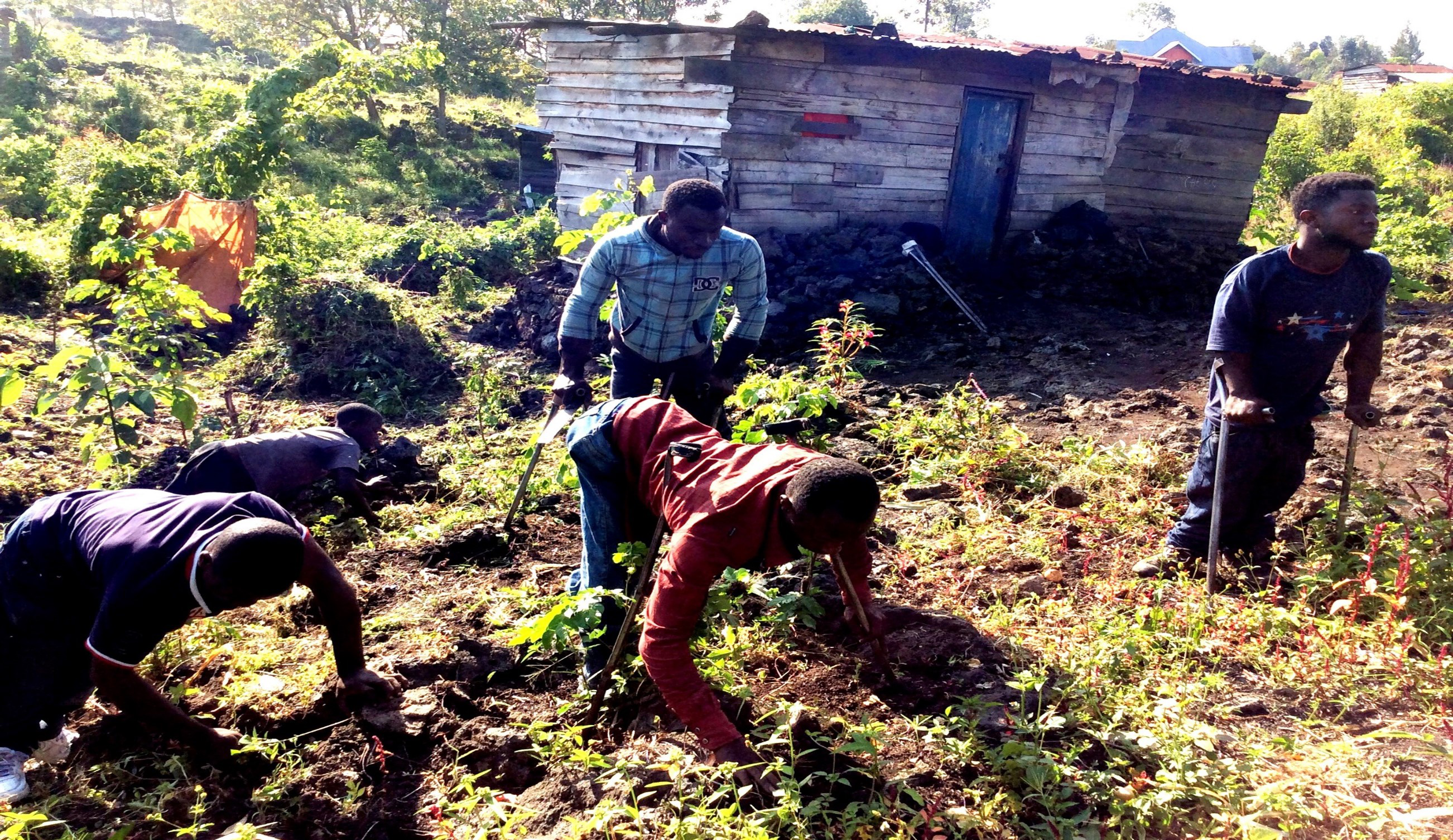
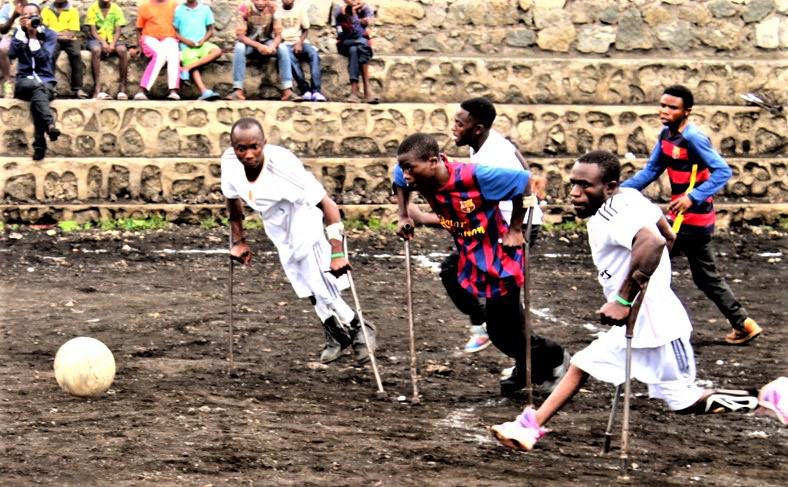
Her sense of humor and her activities, on the other hand, were unbroken: here she is at the Real Madrid vs. FC Barcelona game, another gang of disabled people.
Now all of them have passed their exams, and four of them have already found permanent employment and gotten married!
Their career and financial support activated the bush telegraph throughout eastern Congo – so that by the end of 2024, there were over 200 students and tradespeople, IT specialists and shop tenants who suddenly all had the prospect of an orderly life.
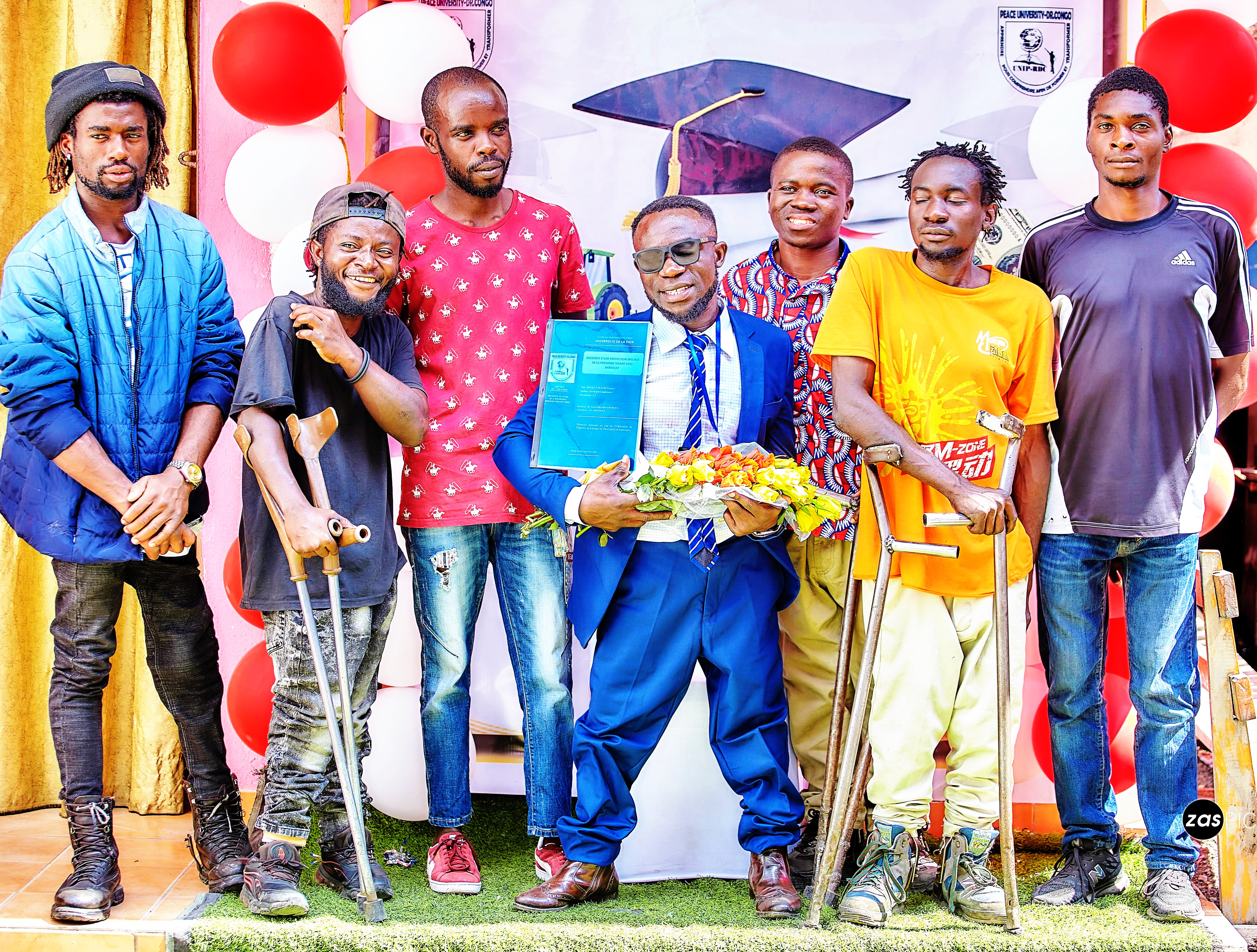
Disabled people are still despised in Congo (because their mother slept with the devil) and rarely get a job. To promote their recognition by society, on March 20, 2023, I founded an organization with six dedicated disabled people, through which my son Martin's “Lemperle Foundation” finances leg splints and crutches for poor paralytics and possible operations for those born disabled.
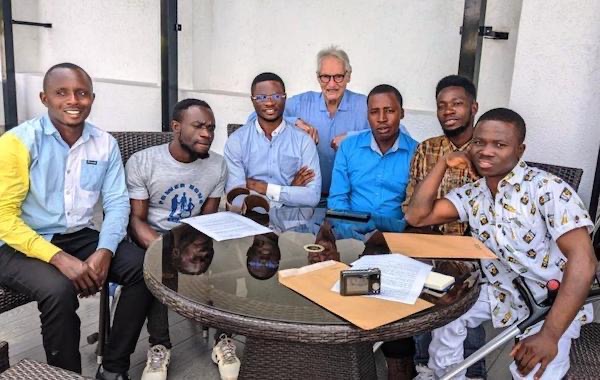
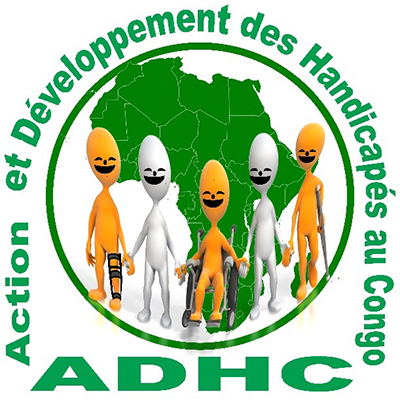
This “organization for the recognition of the disabled” is intended to raise awareness in society. The “Lemperle Foundation” initially financed a prosthesis and leg splint workshop. By the end of 2024, 28 patients with congenital clubfoot or knee joints that are stiff at a right angle (a speciality in Congo) had also been operated on at the Heal Africa Hospital in Goma.
Nabintu with an extreme clubfoot and an extreme flatfoot – successfully operated on for $1300 at Heal Africa Hospital in Goma.
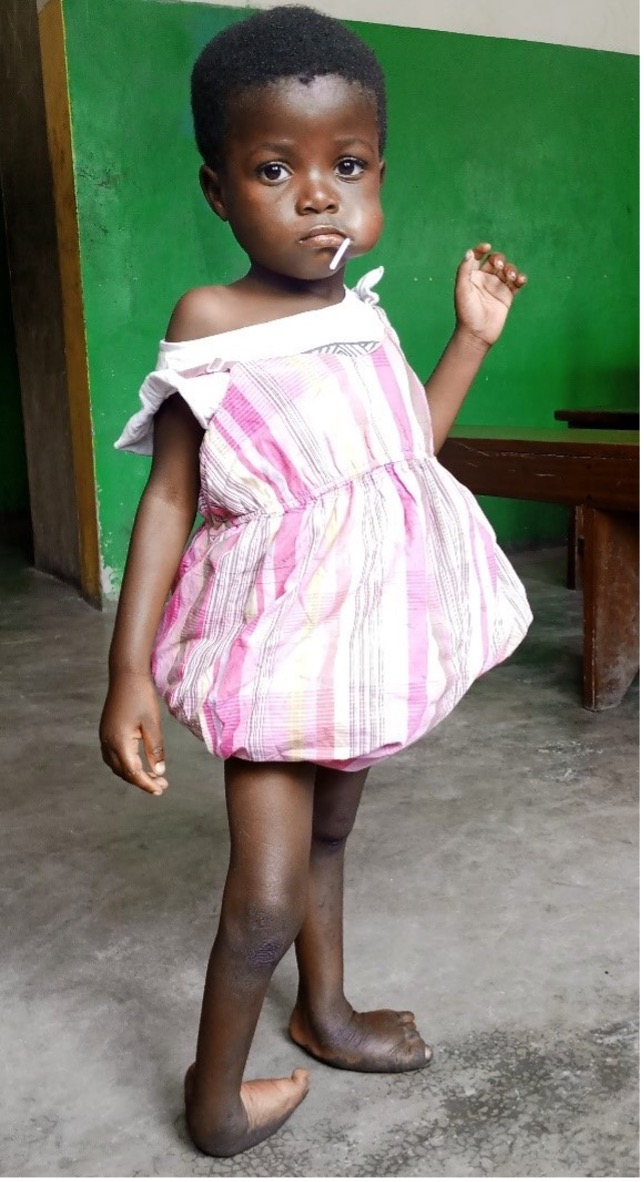
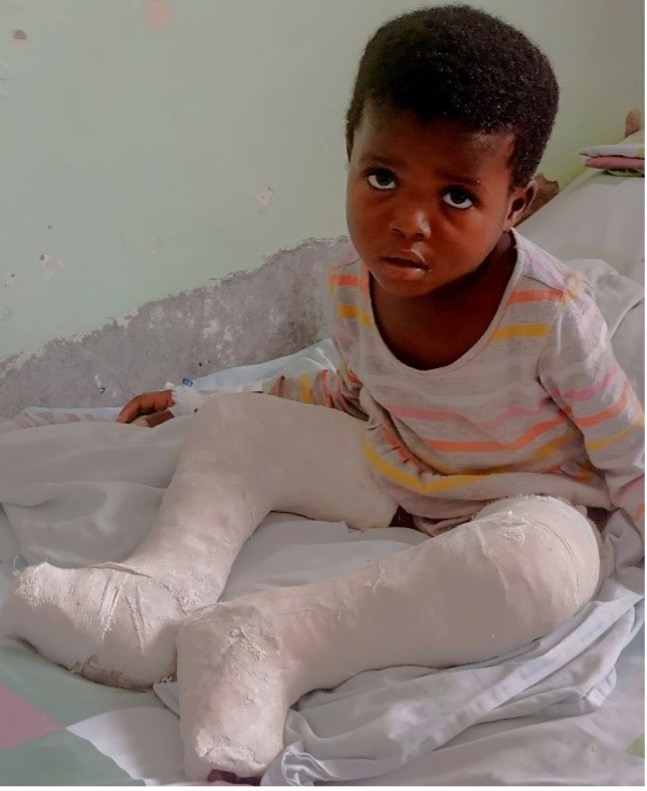
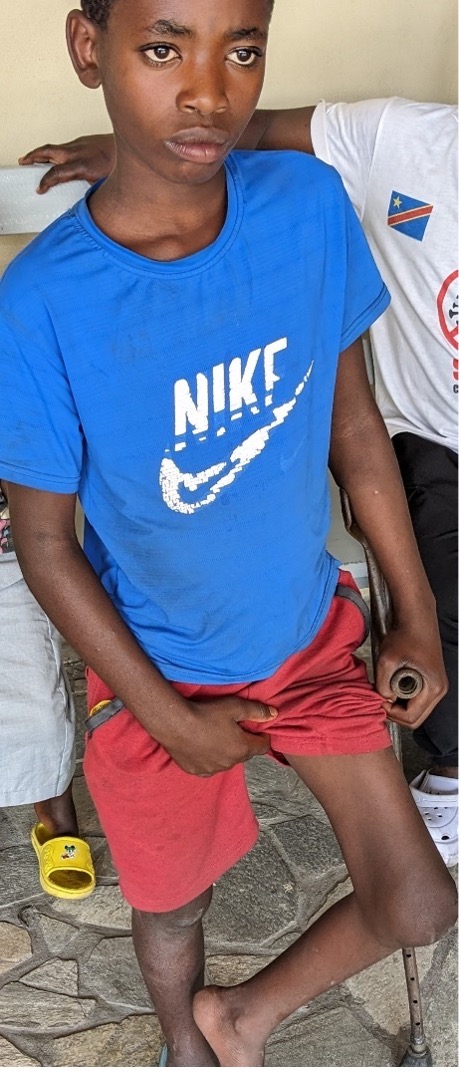
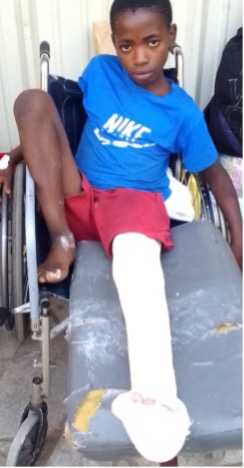
Alain can put down his crutches soon after surgical stretching of his right-angled knee...
Sylvain could only slide around on the floor with his knees in a brace because his hamstrings behind the knee were shortened. An operative lengthening (for $1300) and gradual whining in 2 to 3 plaster casts will straighten his two legs in 2 to 3 months.”
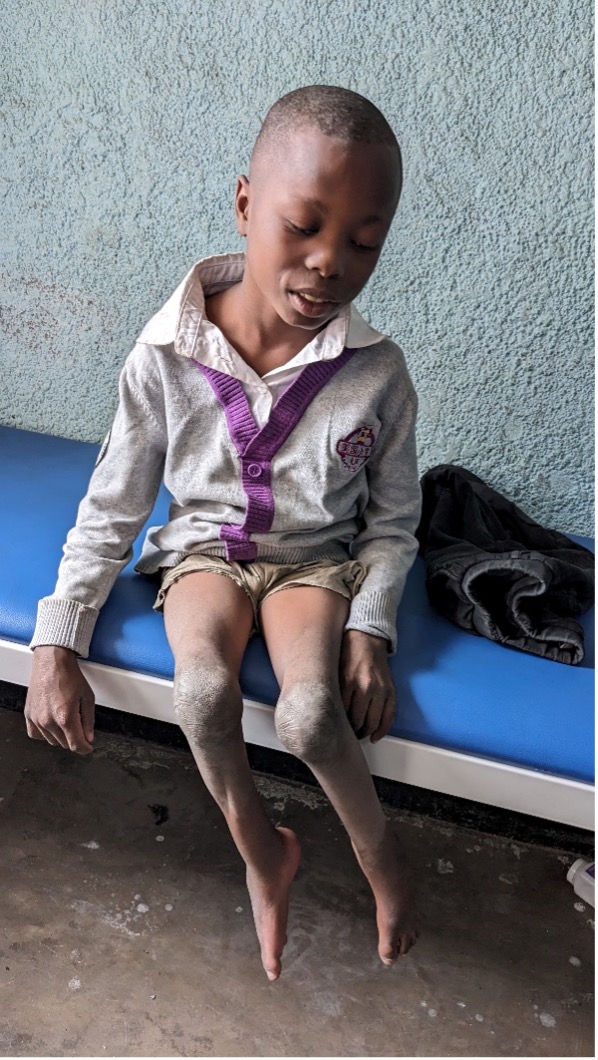
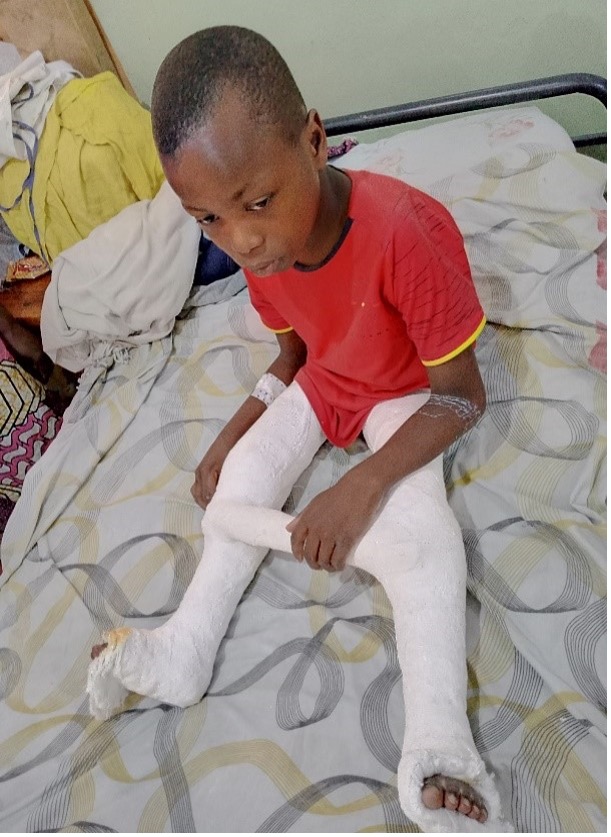
Polio victims with financed studies, workshops and shops.
(Based on transfers from January 1, 2020 and the Jackson list from October 2023. As of December 31, 2024)
| Vocational Training | Number | Average Costs | Donor |
|---|---|---|---|
| Doctors | 12 | 12,000$ | B.Braun Foundation of which 8 |
| Nurses | 16 | ca. 6000$ | B.Braun 6, each 3,500 |
| Midwives | 21 | ca. 6,000$ | B.Braun 4 |
| Laboratory Technicians | 18 | ca. 6,000$ | B.Braun 7 |
| Public Health | 8 | ca. 5,000$ | B.Braun 3 |
| IT Specialists | 17 | ca. 4,000$ | |
| Tradesman | 18 | ca. 2,500$ | |
| Shops | 7 | ca. 1,500$ | |
| Farmland + Hühner | 8 | ca. 1,500$ | |
| Operations | 34 | 1,500$ | Lemperle-Stiftung |
| Various: Other surgeries, customs, notary, website, transfers |
ca. 50,000$ | ||
| Total | 159 | 646,759$ |
LOCAL TRAINING AND INTERNATIONAL MISSIONS
The long-term training of Interplast teams and other specialists from Germany is to be set up at Goma Hospital. At the same time, the first doctors are to be sent to Rwanda and Uganda for further training in their hoped-for specialties. Prof. Lemperle has personally convinced himself of the stark contrast between the medical training in Goma and the medical emergency in the rest of Congo. In intensive discussions with the Bishop of the Nazarenes in Goma, Reverend Bugeshi, effective cooperation was initiated. So far, the B. Braun Foundation has financed the further training of three female doctors to become surgeons in Benin, Kinshasa and Bukavu, and the medical studies of eight students through Interplast.

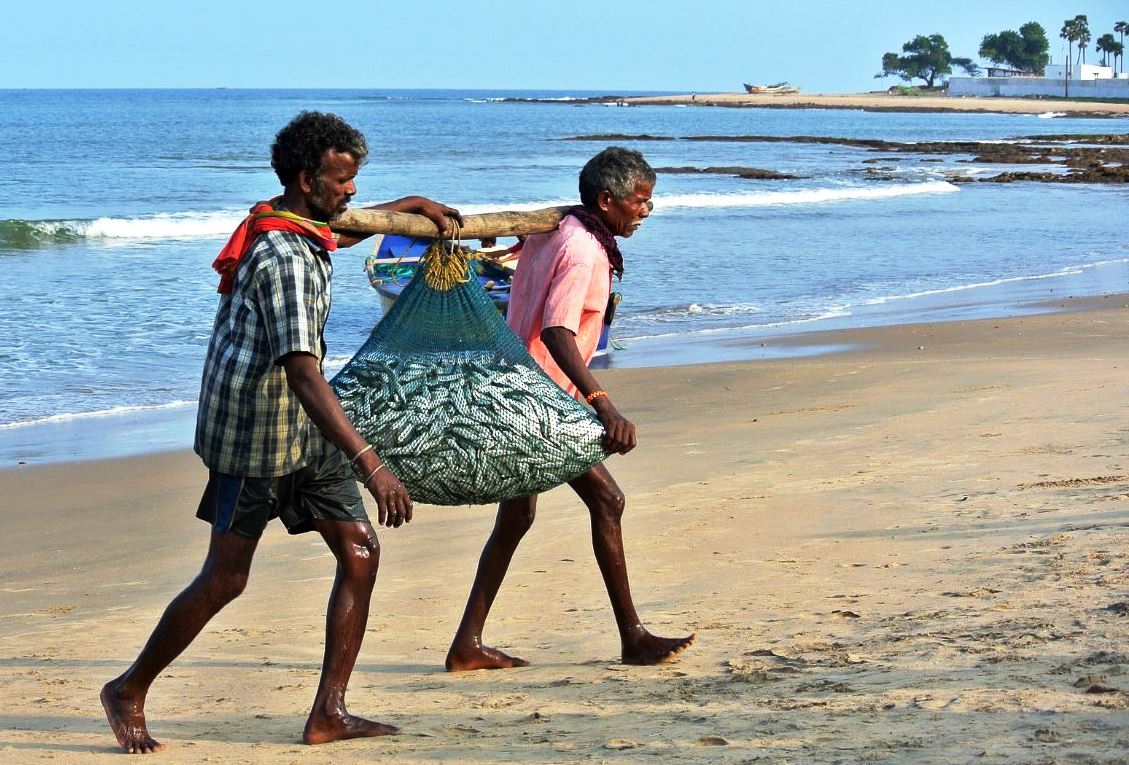
“Give a man a fish and you feed him for a day. Teach a man to fish and you feed him for life” (LaoTse)
This philosophy of sustainability also applies to the hospital's foundation, for whose long-term benefit and effectiveness we care.
Outlook on the Congo
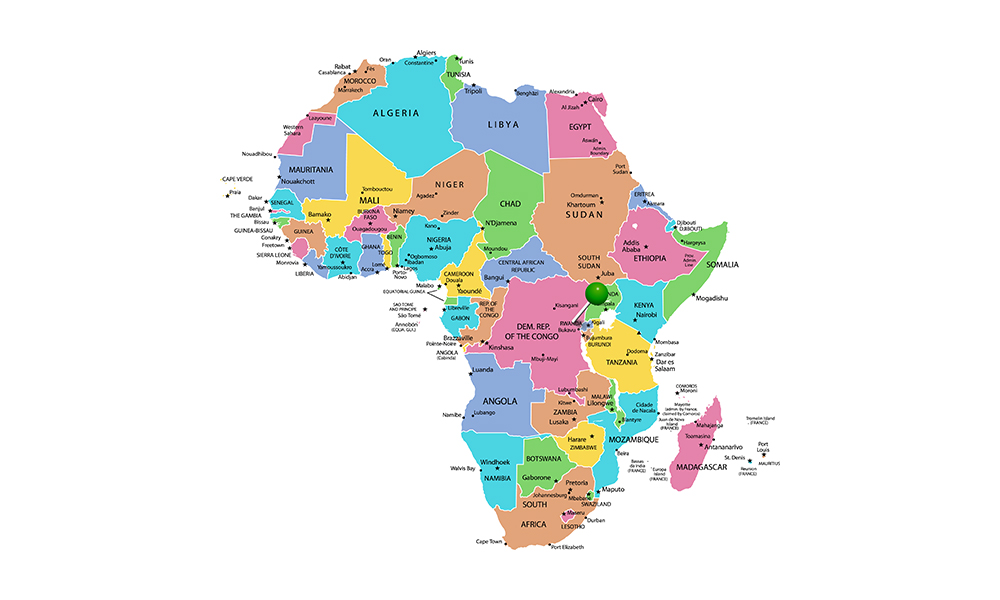
Goma
Today, even with many children, the old parents can no longer expect to be fed by them, because they have to leave the family after school and from then on are on their own! The sudden contact with modern times has destroyed these millennia-old structures of families, villages and clans and forces everyone to look for work today. Saving is not in their heritage, i.e. the fact that children will cost school and education fees and a dowry does not occur to them.
Only those who have connections find work at a young age, i.e. 90% of Congolese “make ends meet”. - On the other hand, we can only envy them for their unbroken cheerfulness.
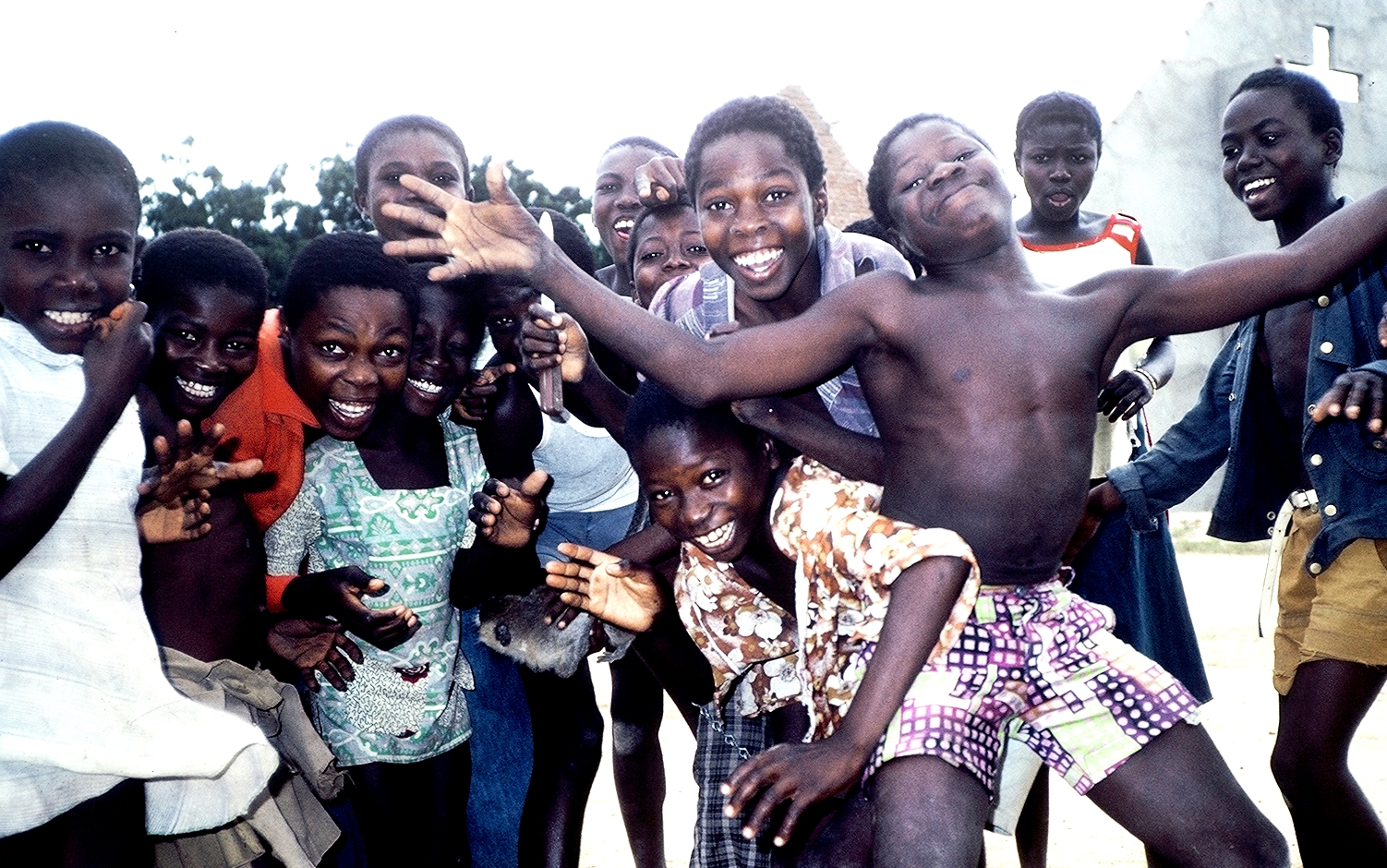
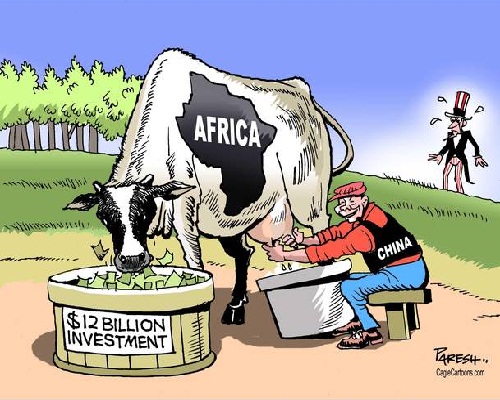
Africa already has more inhabitants than China and India and will have as many inhabitants at the turn of the century as half the world's population today.
Why doesn't Europe finally wake up and change the causes of migration, i.e. create jobs in Africa in the countryside and livestock farming or large sewing factories like in Bangladesh?
The clever Chinese have long since recognized the value of Africa and its mineral resources, while Europe slept for 20 years. They know where gold and rare earths are hidden – and “give” the African governments ports, railways and trains, and highways that end 10 km before the expected precious metals and later diamond fields.
If you fly over Africa today and suddenly see greenery, then the Chinese have set up a farm or tea plantation there; and if you see a lit street or a village at night, then the Chinese are producing electricity there in abundance!
Unfortunately, millions of Congolese are starving here too, even though Congo has the most fertile soil in Africa and its jungle is the third largest CO2 lung in the world. But its inhabitants are incapable of building up a productive agriculture because they have yet to learn true socialism, voluntary cooperation.
“The enemy of the African is another African” goes a modern song from Senegal. Twenty years ago, they were happy in the Congo with a banana in their hands; today they are unhappy with their smartphones in their hands. I see a huge migration of people from sub-Saharan Africa to the north. Hunger has always been the cause of most non-war-related migrations.
Unless Europe finally wakes up and reduces its imports from India, Bangladesh, Vietnam and China, but instead irrigates the Sahara and relocates its energy production, agriculture and technical production to our neighboring continent of Africa.
Despite the richest mineral resources in the world (!) and fertile soil throughout the Congo, children in the cities are starving because there is no “planned economy”.
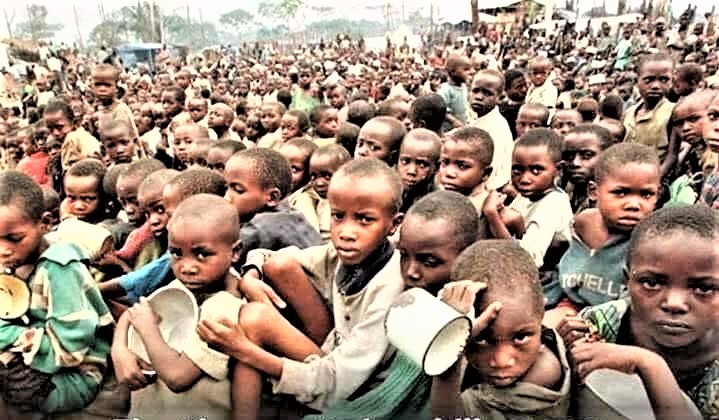
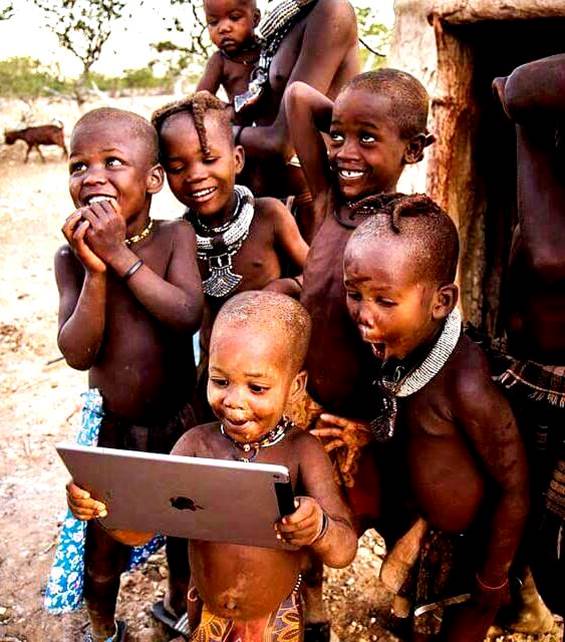
The Congolese are interested and want to achieve something in their lives, but almost all of them lack the starting capital of $2000 (including rent $600) and $8000 for a bachelor's degree to become a nurse or laboratory technician.
Targeted donations to individuals bring income and education to young people in the most corrupt of all countries.
50% of the 90 million Congolese are under 15 years old, without any prospect of work. Where should they go but to flee north to Europe? As long as the big European companies don't drill wells for groundwater under the Sahara and build factories or start farming there, no trend reversal is to be expected.

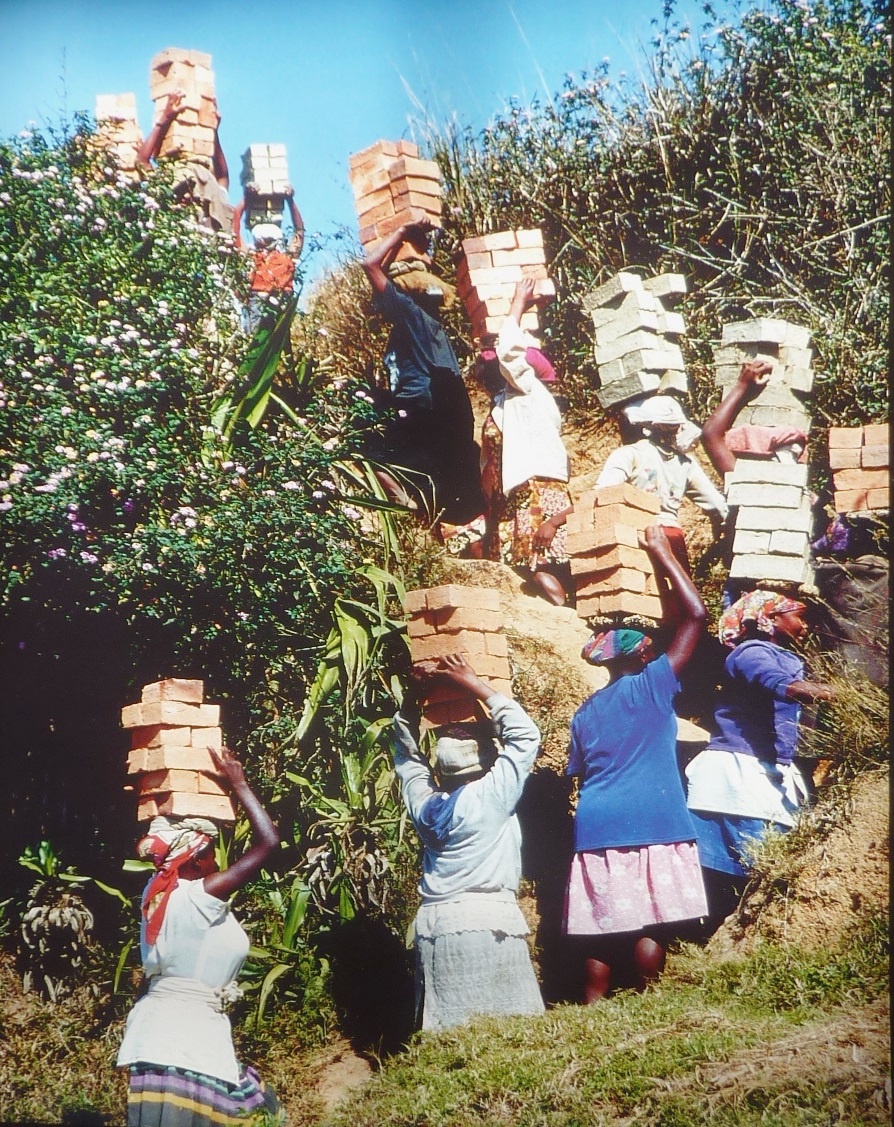
Women have children early, do all the work at home and in the fields, and are abandoned by their ...
Macho men leave her to spend a lifetime working for their children.

Interplast-germany e.V.
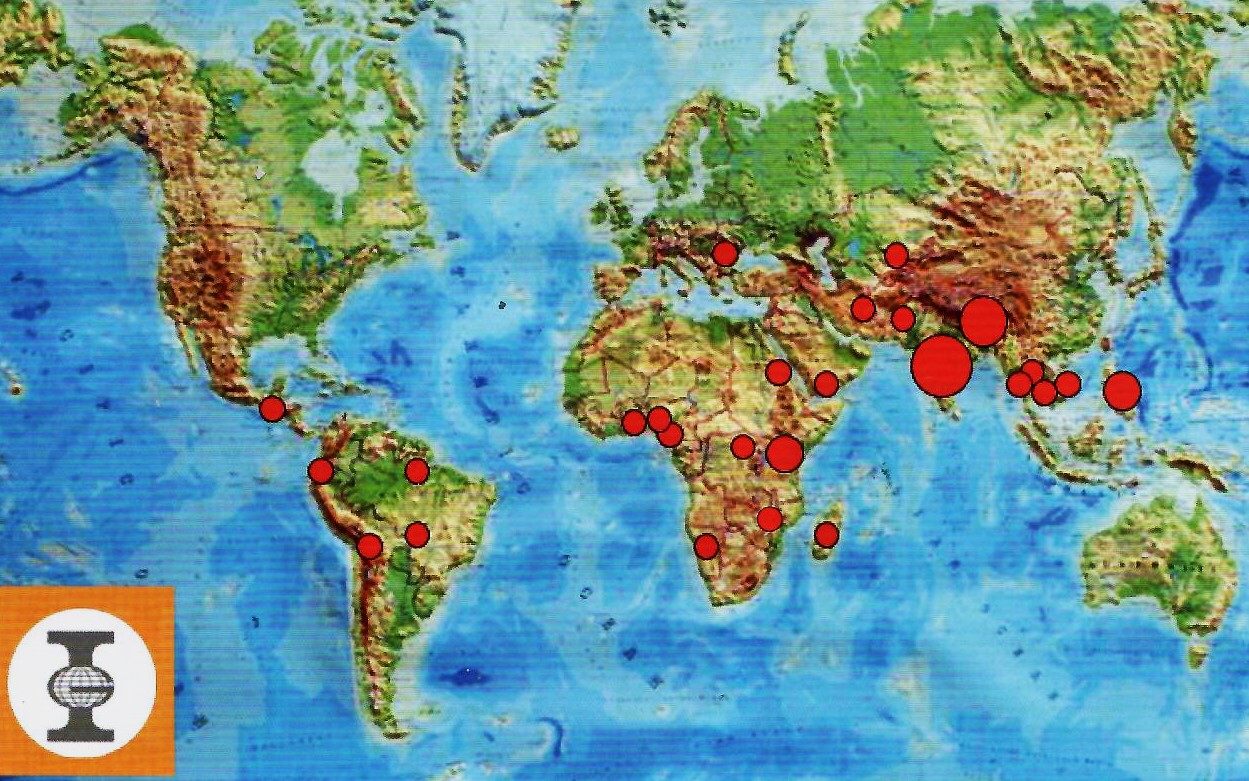
The 2023 INTERPLAST missions worldwide
INTERPLAST-GERMANY e.V was founded in 1980 by Prof. Gottfried Lemperle in Frankfurt, after the tax office did not recognize his costs for flights, material and accommodation in foreign countries as tax-deductible. Also, his Markus Hospital in Frankfurt had stopped treating severely mutilated children from India and Africa free of charge. As a humanitarian aid organization, INTERPLAST was now able to inspire donors and issue donation receipts.
Dr. Lemperle brought the name and statutes with him from Stanford, CA, where the then senior physician and later head of plastic surgery, Donald Laub, MD, faced the same problems with children from Central and South America in 1967. It soon became apparent that 14-day missions of surgical teams to the developing countries in question were much more cost-effective, especially since plastic surgery operations do not require any elaborate diagnostic procedures.
In order to strengthen the initiative of the active colleagues, 15 independent sections were set up in Germany from 1999 under his successor and head physician Dr. André Borsche in Bad Kreuznach, which in 2023 operated on almost 3500 patients worldwide in 76 missions. The REHEMA Hospital is also intended as a point of contact for many INTERPLAST teams, which find all the organizational and operational requirements here.


